Paul van Yperen's Blog, page 203
March 17, 2020
Blessée au coeur (1917)
Today, we end the film specials series with Spanish chocolate cards with a post on the silent French film, Blessée au coeur/Wounded in the heart (1917), starring Jeanne Delvair, Jean Ayme and René Rocher. The film was produced by Pathé Frères, but the director is unknown. The series of 6 cards was produced by Ed. Auber y Pla for Chocolate Pi in Barcelona. The Spanish release title of the film was Herida del corazon and the distributor of the film in Spain was Vilaseca y Ledesma.
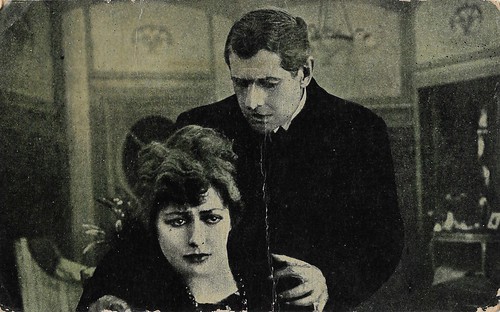
Spanish postcard by Ed. Auber y Pla, Barcelona for Chocolate Pi, Barcelona, no. 1 of 6 cards. Photo: Pathé Frères. Publicity still for Blessée au coeur (1917). The actress is not Jeanne Delvair, but an unknown actress who plays the lady the banker wants to elope with.
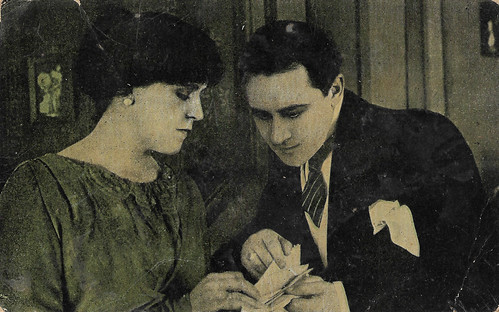
Spanish postcard by Ed. Auber y Pla, Barcelona for Chocolate Pi, Barcelona, no. 2 of 6 cards. Photo: Pathé Frères. Jeanne Delvair and René Rocher in Blessée au coeur (1917).
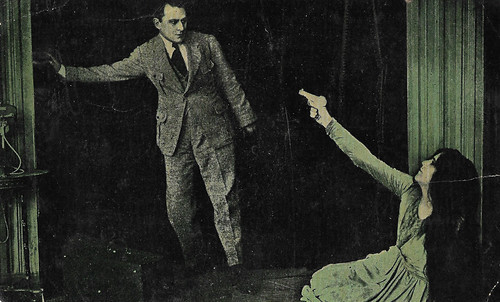
Spanish postcard by Ed. Auber y Pla, Barcelona for Chocolate Pi, Barcelona, no. 3 of 6 cards. Photo: Pathé Frères. Jeanne Delvair and Jean Ayme in Blessée au coeur (1917).
A Shot in the Dark
In Blessée au coeur (1917), the banker Beaupreault (Jean Ayme) has done wild speculations to satisfy his extraordinary needs. One night, while waiting for his wife Marguerite (Jeanne Delvair), he feels the imminent disaster coming. Their son Gérard (René Rocher), unknowing of the debacle, celebrates the passing of his exams.
The opulent rich Robert Dalmarre (Georges Tréville) is prepared to save Marguerite from catastrophe. Beaupreault, who already has prepared his flight with the ex-wife of his attorney Collinet (Jacques Volnys), then hears of the offer his friend is willing to make to save his honour.
Meanwhile, because of alarming rumours around the bank, the creditor Haudecoeur (Jean Chameroy) surprises the banker preparing his luggage, and with a gun in his hand, he demands the restitution of his loans. The banker yields, but this delay is fatal, as Marguerite comes to tell him about her son's success. She quickly understands her husband's plans, and in vain pleas him to renounce to them, but the banker brutally throws her on the ground.
Marguerite finds the gun of Haudecoeur and points it at the banker. Then the banker quickly switches off the electricity to flee. A shot goes off in the dark...
The previous scene lasts briefly, surprising Haudecoeur, who is still on the stairs. The bank staff is surprised to find him in the banker's apartments as he entered without their knowledge, so they suspect him of the killing.
The drama has shocked Marguerite, but when her wits return she learns that the murderer has fallen in the hands of Justice. Marguerite has no doubt she herself has fired the gun on her husband. She is about to declare this before the judge, but her maternal egoism prevents this. The timely arrival of Robert Dalmarre clears her sad thoughts when the latter explains the true murderer was Collinet, who used the darkness created by the banker to kill him to prevent his flight with his own ex-wife.
Collinet is convicted and confesses his crime. Haudecoeur is freed and Marguerite liberated from the doubts that tormented her mind, will forget, with her two loved ones [her son and Robert], the intense drama which was about to steal her reason.
Blessée au coeur was a production by the Société cinématographique des auteurs et gens de lettres (SCAGL), part of Pathé Frères. Pathé also distributed the film. The film was based on a novel (1895) by Jules Mary. According to the newspapers of 1917 on Gallica , the film was released almost simultaneously at the Parisian cinemas Pathé-Palace, Omnia-Pathé and Artistic around 20 April 1917.
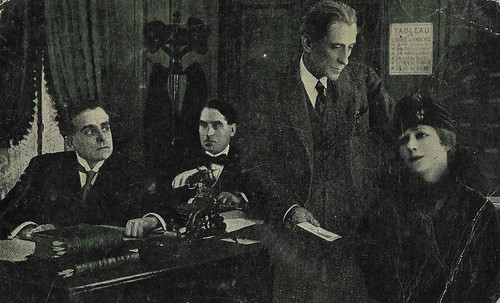
Spanish postcard by Ed. Auber y Pla, Barcelona for Chocolate Pi, Barcelona, no. 4 of 6 cards. Photo: Pathé Frères. Georges Tréville in Blessée au coeur (1917). The actress does not look like Delvair, so she could be the unknown actress who plays the lady with whom the banker planned to flee (see card 1).
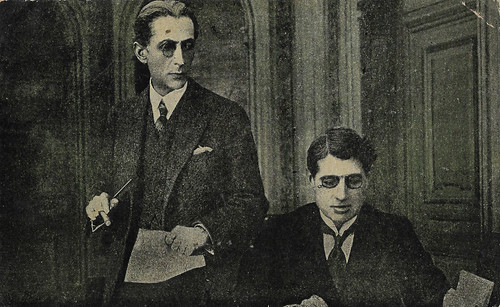
Spanish postcard by Ed. Auber y Pla, Barcelona for Chocolate Pi, Barcelona, no. 5 of 6 cards. Photo: Pathé Frères. Georges Tréville in Blessée au coeur (1917). The actor on the right may be Jacques Volnys.
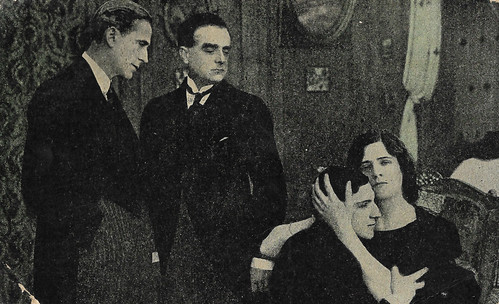
Spanish postcard by Ed. Auber y Pla, Barcelona for Chocolate Pi, Barcelona, no. 6 of 6 cards. Photo: Pathé Frères. Georges Tréville, René Rocher and Jeanne Delvair in Blessée au coeur (1917).
Sources: Wikipedia (French), IMDb, Ciné-Ressources, Fondation Seydoux-Pathé, Gallica, and the collectors cards.
N.B. The French databases only mention Georges Tréville's collaboration but from these cards, it is clear he played Robert Dalmarre.

Spanish postcard by Ed. Auber y Pla, Barcelona for Chocolate Pi, Barcelona, no. 1 of 6 cards. Photo: Pathé Frères. Publicity still for Blessée au coeur (1917). The actress is not Jeanne Delvair, but an unknown actress who plays the lady the banker wants to elope with.

Spanish postcard by Ed. Auber y Pla, Barcelona for Chocolate Pi, Barcelona, no. 2 of 6 cards. Photo: Pathé Frères. Jeanne Delvair and René Rocher in Blessée au coeur (1917).

Spanish postcard by Ed. Auber y Pla, Barcelona for Chocolate Pi, Barcelona, no. 3 of 6 cards. Photo: Pathé Frères. Jeanne Delvair and Jean Ayme in Blessée au coeur (1917).
A Shot in the Dark
In Blessée au coeur (1917), the banker Beaupreault (Jean Ayme) has done wild speculations to satisfy his extraordinary needs. One night, while waiting for his wife Marguerite (Jeanne Delvair), he feels the imminent disaster coming. Their son Gérard (René Rocher), unknowing of the debacle, celebrates the passing of his exams.
The opulent rich Robert Dalmarre (Georges Tréville) is prepared to save Marguerite from catastrophe. Beaupreault, who already has prepared his flight with the ex-wife of his attorney Collinet (Jacques Volnys), then hears of the offer his friend is willing to make to save his honour.
Meanwhile, because of alarming rumours around the bank, the creditor Haudecoeur (Jean Chameroy) surprises the banker preparing his luggage, and with a gun in his hand, he demands the restitution of his loans. The banker yields, but this delay is fatal, as Marguerite comes to tell him about her son's success. She quickly understands her husband's plans, and in vain pleas him to renounce to them, but the banker brutally throws her on the ground.
Marguerite finds the gun of Haudecoeur and points it at the banker. Then the banker quickly switches off the electricity to flee. A shot goes off in the dark...
The previous scene lasts briefly, surprising Haudecoeur, who is still on the stairs. The bank staff is surprised to find him in the banker's apartments as he entered without their knowledge, so they suspect him of the killing.
The drama has shocked Marguerite, but when her wits return she learns that the murderer has fallen in the hands of Justice. Marguerite has no doubt she herself has fired the gun on her husband. She is about to declare this before the judge, but her maternal egoism prevents this. The timely arrival of Robert Dalmarre clears her sad thoughts when the latter explains the true murderer was Collinet, who used the darkness created by the banker to kill him to prevent his flight with his own ex-wife.
Collinet is convicted and confesses his crime. Haudecoeur is freed and Marguerite liberated from the doubts that tormented her mind, will forget, with her two loved ones [her son and Robert], the intense drama which was about to steal her reason.
Blessée au coeur was a production by the Société cinématographique des auteurs et gens de lettres (SCAGL), part of Pathé Frères. Pathé also distributed the film. The film was based on a novel (1895) by Jules Mary. According to the newspapers of 1917 on Gallica , the film was released almost simultaneously at the Parisian cinemas Pathé-Palace, Omnia-Pathé and Artistic around 20 April 1917.

Spanish postcard by Ed. Auber y Pla, Barcelona for Chocolate Pi, Barcelona, no. 4 of 6 cards. Photo: Pathé Frères. Georges Tréville in Blessée au coeur (1917). The actress does not look like Delvair, so she could be the unknown actress who plays the lady with whom the banker planned to flee (see card 1).

Spanish postcard by Ed. Auber y Pla, Barcelona for Chocolate Pi, Barcelona, no. 5 of 6 cards. Photo: Pathé Frères. Georges Tréville in Blessée au coeur (1917). The actor on the right may be Jacques Volnys.

Spanish postcard by Ed. Auber y Pla, Barcelona for Chocolate Pi, Barcelona, no. 6 of 6 cards. Photo: Pathé Frères. Georges Tréville, René Rocher and Jeanne Delvair in Blessée au coeur (1917).
Sources: Wikipedia (French), IMDb, Ciné-Ressources, Fondation Seydoux-Pathé, Gallica, and the collectors cards.
N.B. The French databases only mention Georges Tréville's collaboration but from these cards, it is clear he played Robert Dalmarre.
Published on March 17, 2020 23:00
March 16, 2020
Suzy Delair (1917-2020)
Last Sunday, 15 March 2020, vivacious French actress and singer Suzy Delair (1917) passed away. She starred in many different films and was also famous in France as a singer of songs like Avec son Tra-la-la. For several years, the saucy star was the companion of film director Henri-Georges Clouzot, in whose films of the 1940s she appeared, including the masterpiece Quai des Orfèvres/Quay of the Goldsmiths (1947). La Delair was 102.
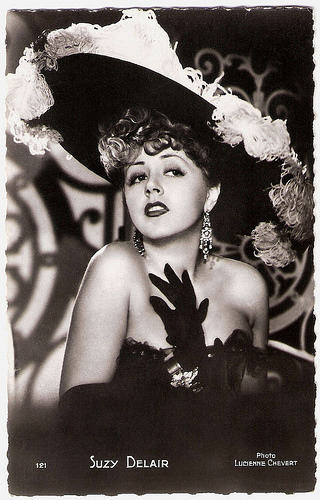
French postcard by Editions P.I., offered by Les Carbones Korès, no. 121. Photo: Lucienne Chevert. Publicity still for Quai des Orfèvres (Henri-Georges Clouzot, 1947).
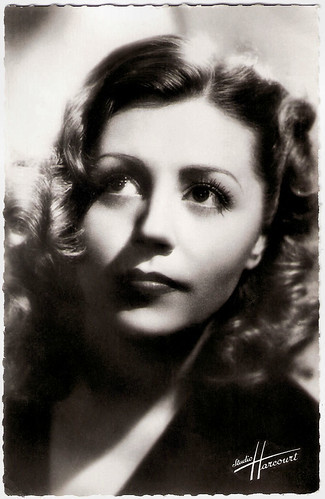
French postcard by Editions O.P., no. 4. Photo: Studio Harcourt.

French postcard by Editions du Globe, Paris, no. 128. Photo: Lucienne Chevert.
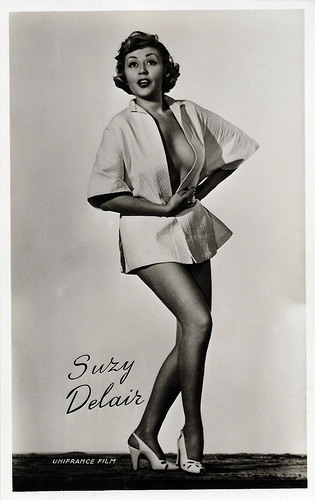
Dutch postcard, no. AX 850. Photo: Unifrance Film.
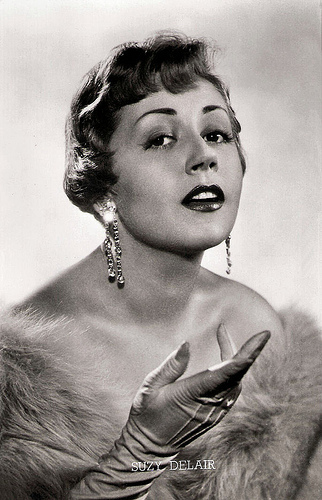
French postcard offered by Korès 'Carboplane', no. 153.
The prototype of the sexy cheeky French lady
Suzanne Pierrette Delaire was born in 1917, in Paris as the daughter of a seamstress and a saddle shop owner.
Her first job was as an apprentice for milliner Suzanne Talbot, but Delaire dreamed of the theatre. As a teenager, she started playing bit parts in films and on stage.
Her film debut was Un caprice de la Pompadour/Madame Pompadour (Willy Wolff, Joë Hamman, 1930). She had her first success in the music-halls and appeared in the cabaret of Suzy Solidor and the revue of Mistinquett .
During the 1930s, she played small parts in films like La Dame de chez Maxim's (Alexander Korda, 1932) based on the play by farceur Georges Feydeau, Poliche (Abel Gance, 1934) with Marie Bell , and Prends la route/Hit the Road (Jean Boyer, 1936).
Finally, her breakthrough in the cinema came with Le Dernier des six/The Last One of the Six (Georges Lacombe, 1941). In this mystery thriller, she played cabaret singer Mila Malou, the unbearable girlfriend of the protagonist, inspector Wens ( Pierre Fresnay ).
The film was based on a script by Henri-Georges Clouzot, with whom Suzy Delair was living together. In 2003, the 85-year-old Delair told the New York Times about Clouzot: "He met me when I was a little debutante, working with Mistinquett . He adored Mistinquett , and he came to one of her shows, where I was singing one of her great successes, Valencia. And he put a cross next to my name. The next time he came to the show, he waited for me at the exit, and we went for a drink. And that lasted for 12 years."
When Clouzot became a director, he offered her two other big successes. First, she returned in the popular sequel to Le Dernier des six, L'assassin habite au 21/The Murderer Lives at Number 21 (Henri-Georges Clouzot, 1942).
Then followed Quai des Orfèvres/Quay of the Goldsmiths (Henri-Georges Clouzot, 1947), which made him the 'French Alfred Hitchcock'. In this classic thriller, Delair played the frivolous music-hall singer Jenny L'Amour who is prepared to do anything to become famous and makes thus her poor husband ( Bernard Blier ) insanely jealous.
With this great part, she emerged to international stardom. At IMDb , Guy Bellinger describes her as the 'prototype of the sexy cheeky French lady'. She was a seductive, stunningly attractive actress with a natural acting style. Sadly, Delair and Clouzot separated and after their successes together, the rest of her film career seems a bit disappointing. However, there are some exceptions.

French postcard, no. 14. Photo: Discina.
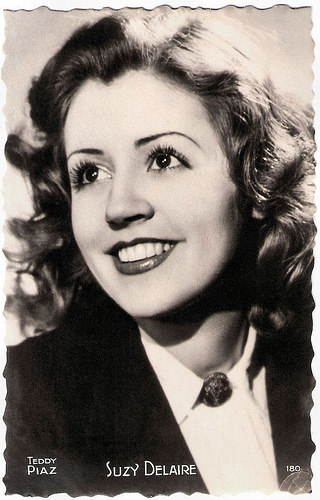
French postcard by Editions O.P., no. 180. Photo: Teddy Piaz.
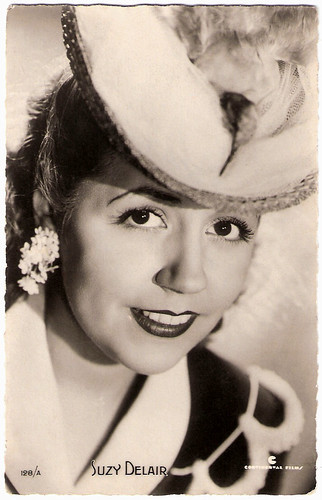
French postcard by Editions Continental, no. 128/A. Photo: Continental Films.
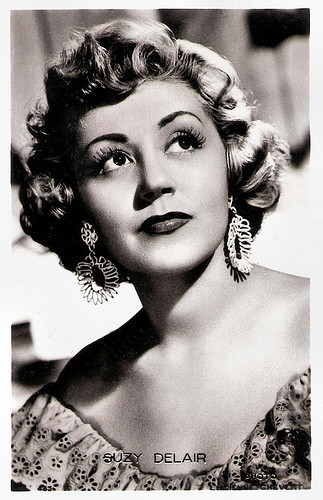
French postcard offered by Editions P.I., no. 13 F. Photo: Lucienne Chevert.
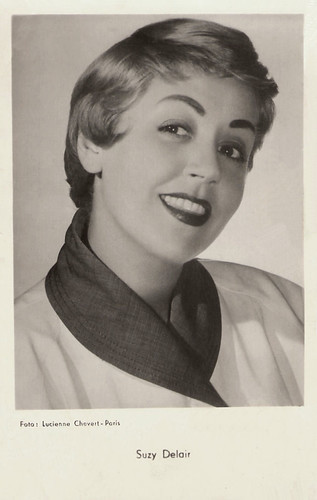
French postcard by Editions P.I., Paris, no. 29 H. P.I. was the French license holder for Universum-Film A.G. (UFA), Berlin-Tempelhof. Photo: Lucienne Chevert.
Avec son Tra-la-la
After the war, Suzy Delair starred in films by major directors like Marcel L'Herbier (La Vie de bohème, 1945), Jean Dréville (Copie conforme/Confessions of a Rogue, 1947), Marcel Carné (Du mouron pour les petits oiseaux/Chicken Feed for Little Birds, 1962), and René Clément (Paris brûle-t-il?/Is Paris Burning?, 1966).
A highlight in her career and a milestone in the history of the cinema was Rocco e i suoi fratelli/Rocco and His Brothers (Luchino Visconti, 1960) starring Alain Delon and Renato Salvatori , even if her part in this operatic masterpiece is a minor one.
Delair covered all registers - from drama to comedy. Ironically, Suzy is probably best known to American filmgoers for what may well be her worst film. In 1950, she appeared as will-of-the-wisp chanteuse Cheri Lamour in the last comedy os the aging Laurel & Hardy , the melancholy Atoll K/Utopia (Léo Joannon, 1951).
She also appeared in the Fernandel vehicle Le Couturier de ces Dames/Fernandel the Dress Maker (Jean Boyer, 1956) and in the hilarious farce Les Aventures de Rabbi Jacob/The Mad Adventures of Rabbi Jacob (Gérard Oury, 1973) starring French comedy star Louis de Funès .
She was a dancer and a singer, and her chanson Avec son Tra-la-la is an evergreen in France. She introduced it in Quai des Orfèvres (1947). Delair also appeared in several operettas by Jacques Offenbach and Oscar and Johan Strauss.
Her last film was Oublie-moi, Mandoline/Forget Me, Mandoline (Michel Wyn, 1976). Since then Suzy Delair only appeared incidentally on television.
Guy Bellinger gives an interesting answer to why Delair was not more famous than she was: "Suzy Delair could hardly choose between her two careers. This may be the reason why she missed out on more great roles than she finally interpreted. Nevertheless, Mila Malou and Jenny Lamour are now part of the French film heritage. Not everybody can boast having left such an imprint on several generations of movie-goers."
Trailer for Quai des Orfèvres (1947). Source: YouTube Movies (YouTube).
Snippet from Atoll K/Utopia (1951). Source: httpdbetreeorg (YouTube).
Suzy Delair sings Moulin rouge in 1966. Source: Ina Chansons (YouTube).
The trailer of Les Aventures de Rabbi Jacob (1973). Source: Night Of The Trailers (YouTube).
Sources: (IMDb), Hal Erickson (AllMovie), Movie Diva, Wikipedia (English and French), and .

French postcard by Editions P.I., offered by Les Carbones Korès, no. 121. Photo: Lucienne Chevert. Publicity still for Quai des Orfèvres (Henri-Georges Clouzot, 1947).

French postcard by Editions O.P., no. 4. Photo: Studio Harcourt.

French postcard by Editions du Globe, Paris, no. 128. Photo: Lucienne Chevert.

Dutch postcard, no. AX 850. Photo: Unifrance Film.

French postcard offered by Korès 'Carboplane', no. 153.
The prototype of the sexy cheeky French lady
Suzanne Pierrette Delaire was born in 1917, in Paris as the daughter of a seamstress and a saddle shop owner.
Her first job was as an apprentice for milliner Suzanne Talbot, but Delaire dreamed of the theatre. As a teenager, she started playing bit parts in films and on stage.
Her film debut was Un caprice de la Pompadour/Madame Pompadour (Willy Wolff, Joë Hamman, 1930). She had her first success in the music-halls and appeared in the cabaret of Suzy Solidor and the revue of Mistinquett .
During the 1930s, she played small parts in films like La Dame de chez Maxim's (Alexander Korda, 1932) based on the play by farceur Georges Feydeau, Poliche (Abel Gance, 1934) with Marie Bell , and Prends la route/Hit the Road (Jean Boyer, 1936).
Finally, her breakthrough in the cinema came with Le Dernier des six/The Last One of the Six (Georges Lacombe, 1941). In this mystery thriller, she played cabaret singer Mila Malou, the unbearable girlfriend of the protagonist, inspector Wens ( Pierre Fresnay ).
The film was based on a script by Henri-Georges Clouzot, with whom Suzy Delair was living together. In 2003, the 85-year-old Delair told the New York Times about Clouzot: "He met me when I was a little debutante, working with Mistinquett . He adored Mistinquett , and he came to one of her shows, where I was singing one of her great successes, Valencia. And he put a cross next to my name. The next time he came to the show, he waited for me at the exit, and we went for a drink. And that lasted for 12 years."
When Clouzot became a director, he offered her two other big successes. First, she returned in the popular sequel to Le Dernier des six, L'assassin habite au 21/The Murderer Lives at Number 21 (Henri-Georges Clouzot, 1942).
Then followed Quai des Orfèvres/Quay of the Goldsmiths (Henri-Georges Clouzot, 1947), which made him the 'French Alfred Hitchcock'. In this classic thriller, Delair played the frivolous music-hall singer Jenny L'Amour who is prepared to do anything to become famous and makes thus her poor husband ( Bernard Blier ) insanely jealous.
With this great part, she emerged to international stardom. At IMDb , Guy Bellinger describes her as the 'prototype of the sexy cheeky French lady'. She was a seductive, stunningly attractive actress with a natural acting style. Sadly, Delair and Clouzot separated and after their successes together, the rest of her film career seems a bit disappointing. However, there are some exceptions.

French postcard, no. 14. Photo: Discina.

French postcard by Editions O.P., no. 180. Photo: Teddy Piaz.

French postcard by Editions Continental, no. 128/A. Photo: Continental Films.

French postcard offered by Editions P.I., no. 13 F. Photo: Lucienne Chevert.

French postcard by Editions P.I., Paris, no. 29 H. P.I. was the French license holder for Universum-Film A.G. (UFA), Berlin-Tempelhof. Photo: Lucienne Chevert.
Avec son Tra-la-la
After the war, Suzy Delair starred in films by major directors like Marcel L'Herbier (La Vie de bohème, 1945), Jean Dréville (Copie conforme/Confessions of a Rogue, 1947), Marcel Carné (Du mouron pour les petits oiseaux/Chicken Feed for Little Birds, 1962), and René Clément (Paris brûle-t-il?/Is Paris Burning?, 1966).
A highlight in her career and a milestone in the history of the cinema was Rocco e i suoi fratelli/Rocco and His Brothers (Luchino Visconti, 1960) starring Alain Delon and Renato Salvatori , even if her part in this operatic masterpiece is a minor one.
Delair covered all registers - from drama to comedy. Ironically, Suzy is probably best known to American filmgoers for what may well be her worst film. In 1950, she appeared as will-of-the-wisp chanteuse Cheri Lamour in the last comedy os the aging Laurel & Hardy , the melancholy Atoll K/Utopia (Léo Joannon, 1951).
She also appeared in the Fernandel vehicle Le Couturier de ces Dames/Fernandel the Dress Maker (Jean Boyer, 1956) and in the hilarious farce Les Aventures de Rabbi Jacob/The Mad Adventures of Rabbi Jacob (Gérard Oury, 1973) starring French comedy star Louis de Funès .
She was a dancer and a singer, and her chanson Avec son Tra-la-la is an evergreen in France. She introduced it in Quai des Orfèvres (1947). Delair also appeared in several operettas by Jacques Offenbach and Oscar and Johan Strauss.
Her last film was Oublie-moi, Mandoline/Forget Me, Mandoline (Michel Wyn, 1976). Since then Suzy Delair only appeared incidentally on television.
Guy Bellinger gives an interesting answer to why Delair was not more famous than she was: "Suzy Delair could hardly choose between her two careers. This may be the reason why she missed out on more great roles than she finally interpreted. Nevertheless, Mila Malou and Jenny Lamour are now part of the French film heritage. Not everybody can boast having left such an imprint on several generations of movie-goers."
Trailer for Quai des Orfèvres (1947). Source: YouTube Movies (YouTube).
Snippet from Atoll K/Utopia (1951). Source: httpdbetreeorg (YouTube).
Suzy Delair sings Moulin rouge in 1966. Source: Ina Chansons (YouTube).
The trailer of Les Aventures de Rabbi Jacob (1973). Source: Night Of The Trailers (YouTube).
Sources: (IMDb), Hal Erickson (AllMovie), Movie Diva, Wikipedia (English and French), and .
Published on March 16, 2020 23:00
March 15, 2020
Ruggero Ruggeri
Ruggero Ruggeri (1871-1953) was one the most important Italian stage actors of the first half of the twentieth century, who often performed the plays by Pirandello. He did act in films too, both in silent and sound films. Nowadays, he is best remembered as the voice of Jesus in the Don Camillo films.
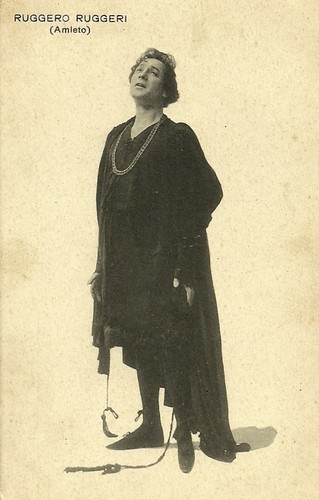
Italian postcard, no. 8067. Photo: Ruggero Ruggeri as Hamlet, either on stage or in the film Amleto (Eleuterio Rodolfi, 1917).
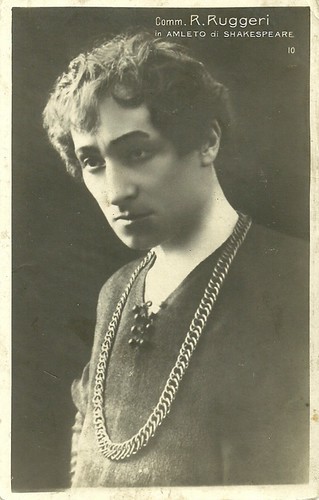
Italian postcard, no. 10. Editor unknown. Ruggero Ruggeri as Hamlet.
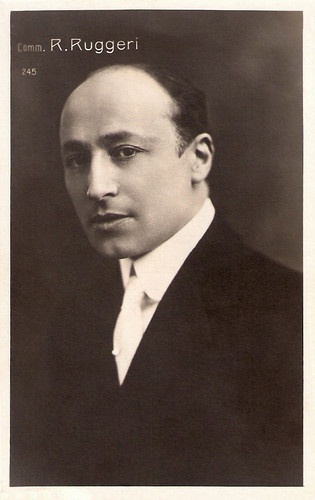
Italian postcard by Ed. Vettori, Bologna, no. 245.
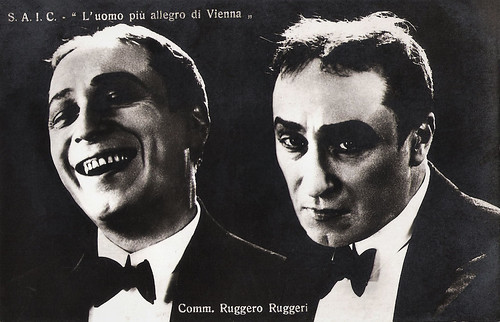
Italian postcard by Ed. A. Traldi, Milano. Photo: S.A.I.C. Ruggero Ruggeri in L'uomo più allegro di Vienna/The Most Cheerful Man in Vienna (Amleto Palermi, 1925).
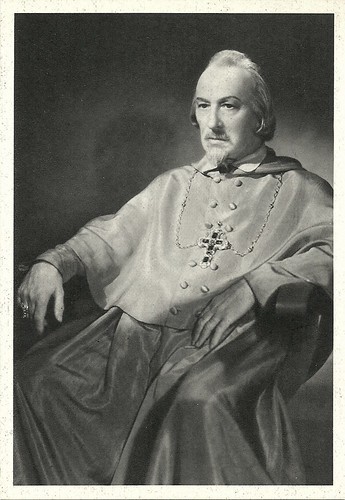
Italian postcard by S.A. Grafitalia, Milano (Milan), no. 10. Photo: Film Lux. Ruggero Ruggeri as Cardinal Federigo Borromeo in I Promessi Sposi/The Spirit and the Flesh (Mario Camerini, 1941).
Multi Colored Voice
Ruggero Ruggeri was born in Fano, in the Italian region Marches in 1871. His father was Augusto Ruggeri and his mother Corina Casazza.
As an actor, he broke with the histrionic acting style, so typical for 19th-century theatre and instead opted for a more restrained, sober style, only with some stylisation of his gestures.
His multi-coloured voice was very popular. He was famous for his role in 'La figlia di Jorio' (The Daughter of Jorio) by Gabriele D'Annunzio, but he was also the most important performer of Luigi Pirandello's stage plays, such as 'Enrico IV'(Henry IV), purposely written for Ruggeri.
Ruggeri was leader of various theatre companies, with actresses such as Emma Grammatica , Lyda Borelli , and Wanda Capodaglio with whom he was also glorified abroad, because of their frequent tours.
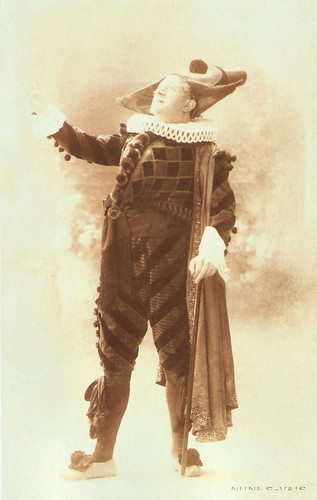
French postcard. Photo: Nunes-Vais.
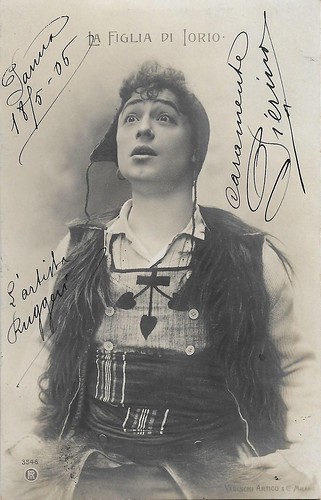
Italian postcard by RPH, no. 3546. Photo: Varischi Artico.& Co., Milano. Mailed 18 May 1906. Ruggero Ruggeri in the stage play La figlia di Jorio (1906).
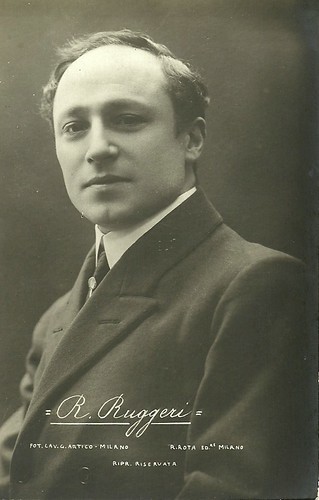
Italian postcard by R. Rota Ed., Milano. Photo: cav. G. Artico, Milano.
Silent Era
From 1914 on, Ruggero Ruggeri played in eleven silent films.
First, he was seen in a series of dramas and comedies for the Cines company, like Veli di giovinezza/Veils of Youth (Nino Oxilia, 1914) and Papa (Nino Oxilia, 1915).
At Cines, Ruggeri was often paired with diva Pina Menichelli . Director Nino Oxilia was killed in service during the First World War, shortly after Italy joined the Allied forces.
In 1917 Ruggeri followed this with a memorable film adaptation of William Shakespeare's Hamlet: Amleto (Eleuterio Rodolfi, 1917), with Helena Makowska as Ophelia and Mercedes Brignone as Gertrude. Outside of Italy the film was released only after the war.
In the mid-1920s, Ruggeri would perform in films by Amleto Palermi and Augusto Genina, and in 1930 he appeared opposite Francesca Bertini in La donna di una notte/The Woman of A Night, the Italian version of Königin der Nacht, directed by Marcel L'Herbier, who demanded his name be to be removed, because the film was edited without his consent.
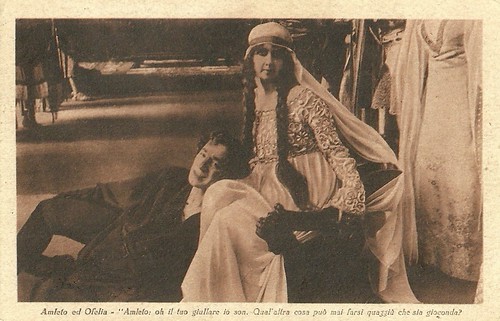
Italian postcard for the film Amleto (Eleuterio Rodolfi, 1917), adapted from Shakespeare's play Hamlet, and starring Ruggero Ruggeri in the title role, here also with Helena Makowska as Ophelia. Caption: Hamlet: Oh, I am your jester. What else can one ever do down here that is joyous?
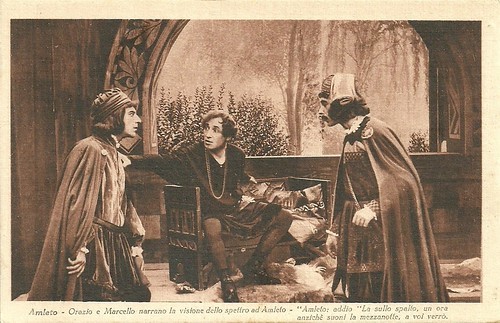
Italian postcard. Ruggero Ruggeri as Hamlet in Amleto (Eleuterio Rodolfi, 1917). The caption says: Horatio and Marcellus tell Hamlet of their vision of the ghost. Hamlet responds (Shakespeare's words): 'Upon the platform, 'twixt eleven and twelve, I'll visit you.'
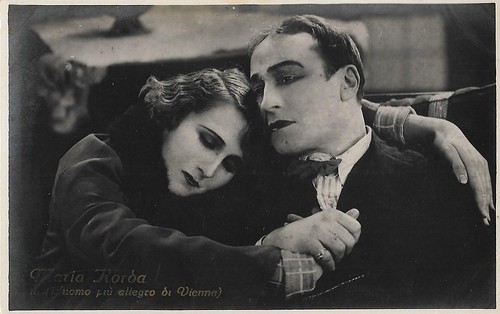
Italian postcard. Photo: Palermi Films. Maria Corda and Ruggero Ruggeri in L'uomo più allegro di Vienna (Amleto Palermi, 1925).

Italian postcard, no. 624. Photo: Sciutto.
The Voice of Jesus
In the late 1930s and early 1940s, when Ruggero Ruggeri was already in his sixties and seventies, he performed in ten Italian films, often as the lead, for companies as Scalera and Lux.
These films included La vedova/The Widow (Goffredo Alessandrini, 1939), Il documento/The Document (Mario Camerini, 1939) with María Denis , and I promesi sposi/The Spirit and the Flesh (Mario Camerini, 1941) with Gino Cervi .
He also appeared in Gelosia/Jealousy (Ferdinando Maria Poggioli, 1942), and played Napoleon in Sant'Elena, piccola isola/Daint Helens - Small Island (Umberto Scarpelli, Renato Simoni, 1942). He also worked as a voice actor, dubbing foreign actors for Italian release.
Ruggeri's best known performance today is only oral. Most older Italians will know him as the voice of Jesus in Don Camillo (1952) and in Le retour de Don Camillo/The Return of Don Camillo (1953), both directed by Julien Duvivier.
Ruggero Ruggeri died in Milano in 1953. He was 81. Ruggeri was interred at the Cimitero Monumentale di Milano in Milan.
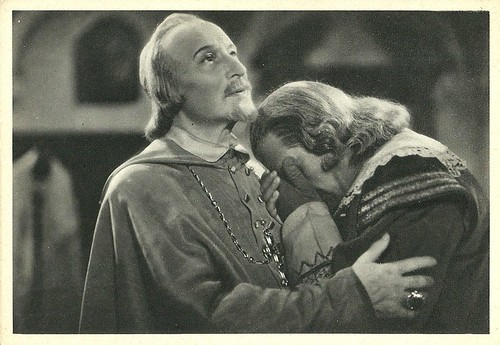
Italian postcard by SA Grafitalia, Roma. Photo: Lux Film. Ruggero Ruggeri as Cardinal Federigo Borromeo offers solace to the repenting Innominato (Carlo Ninchi) in I Promessi Sposi/The Spirit and the Flesh (Mario Camerini, 1941).
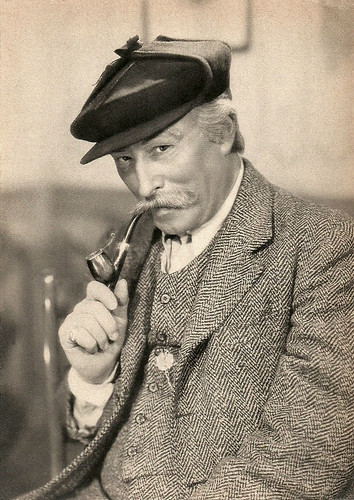
Italian postcard by Rotocalco Dagnino, Torino. Photo: Lux. Ruggero Ruggeri as Papà Martin in the drama La gerla di papà Martin (Mario Bonnard, 1940), an adaptation by the Italian Lux company of the popular drama Les crochets du père Martin by Eugène Cormon and Eugène Grangé. Among Ruggeri's co-actors in this film were Germana Paolieri , Roberto Villa , Enrico Glori and Maria Mercader .
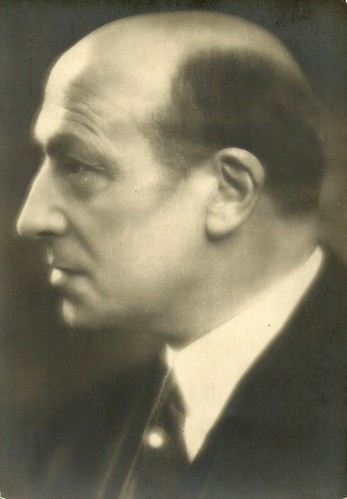
Italian postcard by Alterocca, Terni XIX [1941], no. 7097. Photo: Camuzzi.
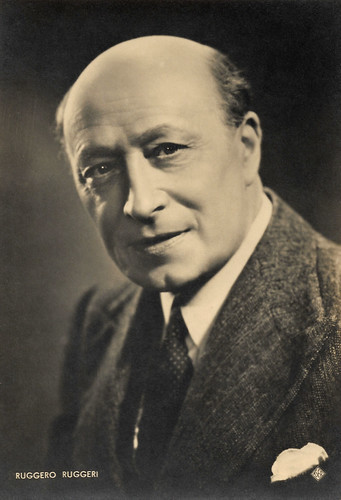
Italian postcard by ASER (A. Scaramaglia Edizioni Roma), no. 64. Photo: Pesce.
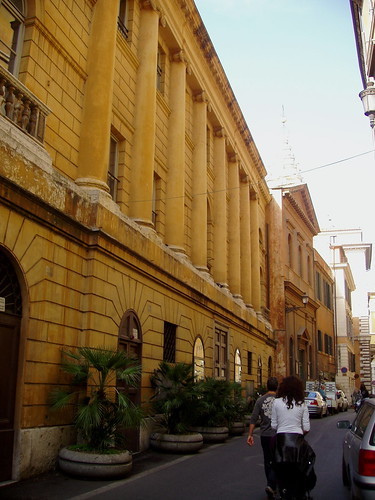
Teatro Valle, Rome. Ruggero Ruggeri and Lyda Borelli often performed in this prominent Roman theatre. The Teatro Valle was built in 1727 as a wooden structure by Tommaso Morelli, enlarged and turned into stone in 1765 by architect Francesco Fiori and radically transformed, embellished and enlarged in 1821 by architect Giuseppe Valadier. Photo: Ivo Blom.
Sources: Wikipedia (Italian) and .

Italian postcard, no. 8067. Photo: Ruggero Ruggeri as Hamlet, either on stage or in the film Amleto (Eleuterio Rodolfi, 1917).

Italian postcard, no. 10. Editor unknown. Ruggero Ruggeri as Hamlet.

Italian postcard by Ed. Vettori, Bologna, no. 245.

Italian postcard by Ed. A. Traldi, Milano. Photo: S.A.I.C. Ruggero Ruggeri in L'uomo più allegro di Vienna/The Most Cheerful Man in Vienna (Amleto Palermi, 1925).

Italian postcard by S.A. Grafitalia, Milano (Milan), no. 10. Photo: Film Lux. Ruggero Ruggeri as Cardinal Federigo Borromeo in I Promessi Sposi/The Spirit and the Flesh (Mario Camerini, 1941).
Multi Colored Voice
Ruggero Ruggeri was born in Fano, in the Italian region Marches in 1871. His father was Augusto Ruggeri and his mother Corina Casazza.
As an actor, he broke with the histrionic acting style, so typical for 19th-century theatre and instead opted for a more restrained, sober style, only with some stylisation of his gestures.
His multi-coloured voice was very popular. He was famous for his role in 'La figlia di Jorio' (The Daughter of Jorio) by Gabriele D'Annunzio, but he was also the most important performer of Luigi Pirandello's stage plays, such as 'Enrico IV'(Henry IV), purposely written for Ruggeri.
Ruggeri was leader of various theatre companies, with actresses such as Emma Grammatica , Lyda Borelli , and Wanda Capodaglio with whom he was also glorified abroad, because of their frequent tours.

French postcard. Photo: Nunes-Vais.

Italian postcard by RPH, no. 3546. Photo: Varischi Artico.& Co., Milano. Mailed 18 May 1906. Ruggero Ruggeri in the stage play La figlia di Jorio (1906).

Italian postcard by R. Rota Ed., Milano. Photo: cav. G. Artico, Milano.
Silent Era
From 1914 on, Ruggero Ruggeri played in eleven silent films.
First, he was seen in a series of dramas and comedies for the Cines company, like Veli di giovinezza/Veils of Youth (Nino Oxilia, 1914) and Papa (Nino Oxilia, 1915).
At Cines, Ruggeri was often paired with diva Pina Menichelli . Director Nino Oxilia was killed in service during the First World War, shortly after Italy joined the Allied forces.
In 1917 Ruggeri followed this with a memorable film adaptation of William Shakespeare's Hamlet: Amleto (Eleuterio Rodolfi, 1917), with Helena Makowska as Ophelia and Mercedes Brignone as Gertrude. Outside of Italy the film was released only after the war.
In the mid-1920s, Ruggeri would perform in films by Amleto Palermi and Augusto Genina, and in 1930 he appeared opposite Francesca Bertini in La donna di una notte/The Woman of A Night, the Italian version of Königin der Nacht, directed by Marcel L'Herbier, who demanded his name be to be removed, because the film was edited without his consent.

Italian postcard for the film Amleto (Eleuterio Rodolfi, 1917), adapted from Shakespeare's play Hamlet, and starring Ruggero Ruggeri in the title role, here also with Helena Makowska as Ophelia. Caption: Hamlet: Oh, I am your jester. What else can one ever do down here that is joyous?

Italian postcard. Ruggero Ruggeri as Hamlet in Amleto (Eleuterio Rodolfi, 1917). The caption says: Horatio and Marcellus tell Hamlet of their vision of the ghost. Hamlet responds (Shakespeare's words): 'Upon the platform, 'twixt eleven and twelve, I'll visit you.'

Italian postcard. Photo: Palermi Films. Maria Corda and Ruggero Ruggeri in L'uomo più allegro di Vienna (Amleto Palermi, 1925).

Italian postcard, no. 624. Photo: Sciutto.
The Voice of Jesus
In the late 1930s and early 1940s, when Ruggero Ruggeri was already in his sixties and seventies, he performed in ten Italian films, often as the lead, for companies as Scalera and Lux.
These films included La vedova/The Widow (Goffredo Alessandrini, 1939), Il documento/The Document (Mario Camerini, 1939) with María Denis , and I promesi sposi/The Spirit and the Flesh (Mario Camerini, 1941) with Gino Cervi .
He also appeared in Gelosia/Jealousy (Ferdinando Maria Poggioli, 1942), and played Napoleon in Sant'Elena, piccola isola/Daint Helens - Small Island (Umberto Scarpelli, Renato Simoni, 1942). He also worked as a voice actor, dubbing foreign actors for Italian release.
Ruggeri's best known performance today is only oral. Most older Italians will know him as the voice of Jesus in Don Camillo (1952) and in Le retour de Don Camillo/The Return of Don Camillo (1953), both directed by Julien Duvivier.
Ruggero Ruggeri died in Milano in 1953. He was 81. Ruggeri was interred at the Cimitero Monumentale di Milano in Milan.

Italian postcard by SA Grafitalia, Roma. Photo: Lux Film. Ruggero Ruggeri as Cardinal Federigo Borromeo offers solace to the repenting Innominato (Carlo Ninchi) in I Promessi Sposi/The Spirit and the Flesh (Mario Camerini, 1941).

Italian postcard by Rotocalco Dagnino, Torino. Photo: Lux. Ruggero Ruggeri as Papà Martin in the drama La gerla di papà Martin (Mario Bonnard, 1940), an adaptation by the Italian Lux company of the popular drama Les crochets du père Martin by Eugène Cormon and Eugène Grangé. Among Ruggeri's co-actors in this film were Germana Paolieri , Roberto Villa , Enrico Glori and Maria Mercader .

Italian postcard by Alterocca, Terni XIX [1941], no. 7097. Photo: Camuzzi.

Italian postcard by ASER (A. Scaramaglia Edizioni Roma), no. 64. Photo: Pesce.

Teatro Valle, Rome. Ruggero Ruggeri and Lyda Borelli often performed in this prominent Roman theatre. The Teatro Valle was built in 1727 as a wooden structure by Tommaso Morelli, enlarged and turned into stone in 1765 by architect Francesco Fiori and radically transformed, embellished and enlarged in 1821 by architect Giuseppe Valadier. Photo: Ivo Blom.
Sources: Wikipedia (Italian) and .
Published on March 15, 2020 23:00
March 14, 2020
New Acquisitions: Vom Werden deutscher Filmkunst - Der Tonfilm, Part 1
In 2017, EFSP did a series of posts on collectors cards by Ross Verlag called 'Vom Werden deutscher Filmkunst' (From the becoming of German film art). The cards of this series, album no. 10, contained pictures of the German silent cinema. Lately, we found cards from another series, album no. 11, which treats the German sound film, Der Tonfilm. And again, some of the cards are smaller than postcards, others bigger, and all are in black and white. And this series includes also star portraits and film scenes, but pictures of film sets and one of the Ufa studios in Babelsberg too. The collectors cards date from around 1935 and album no. 11 contains cards with scenes from the popular Operetta films but also of Nazi propaganda films. Today, the first part of the series.
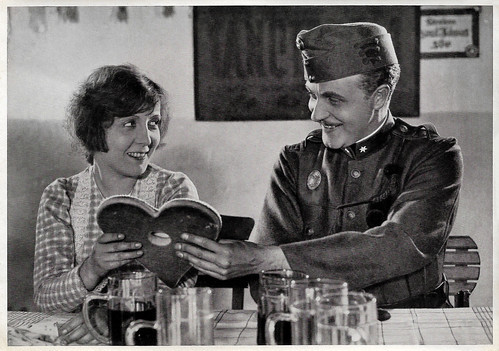
German collectors card in the series 'Vom Werden deutscher Filmkunst - Der Tonfilm', album no. 11, picture no. 4. Photo: Ufa / Ross Verlag. Dita Parlo and Willy Fritsch in Melodie des Herzens/Melody of the Heart (Hanns Schwarz, 1929).
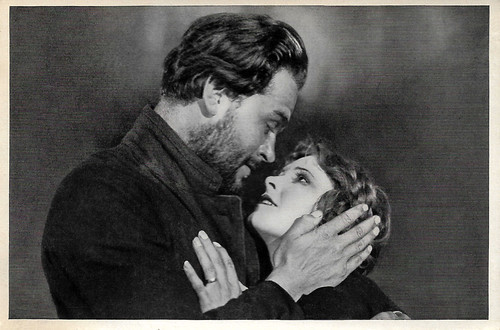
German collectors card in the series 'Vom Werden deutscher Filmkunst - Der Tonfilm', album no. 11, picture no. 6, group 44. Photo: Ufa / Ross Verlag. Gustav Fröhlich and Liane Haid in Die unsterbliche Lump/The Immortal Vagabond (Gustav Ucicky, Joe May, 1930).
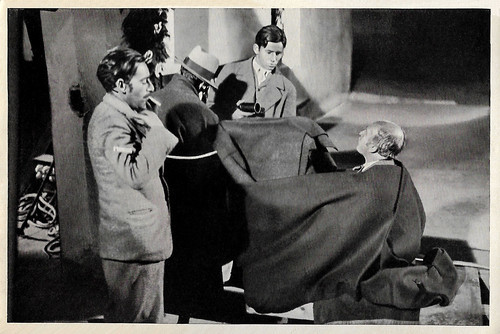
German collectors card in the series 'Vom Werden deutscher Filmkunst - Der Tonfilm', album no. 11, picture no. 12. Photo: Ufa / Ross Verlag. Caption: Karl Hoffmann hüllt sich und seine summende Kamera in dicke Tücher ein. (Karl Hoffmann wraps himself and his buzzing camera in thick cloths.)
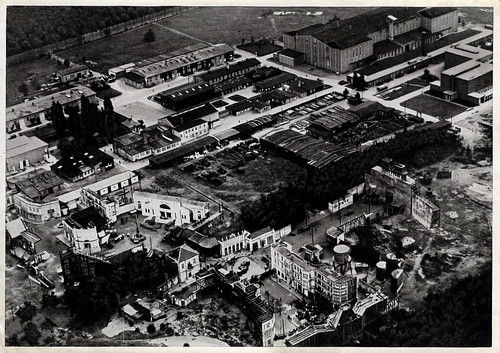
German collectors card in the series 'Vom Werden deutscher Filmkunst - Der Tonfilm', album no. 11, picture no. 16. Photo: Ufa / Ross Verlag. Caption: Ufa-Gelände Neubabelsberg, mit mehr als 430000 qm gesamtfläche und 11 grossen Atelierhallen der grösste Atelierbetrieb in ganz Europa. (The Ufa site Neubabelsberg, with a total area of more than 430,000 square meters and 11 big studio halls, the largest film studio in Europe.)
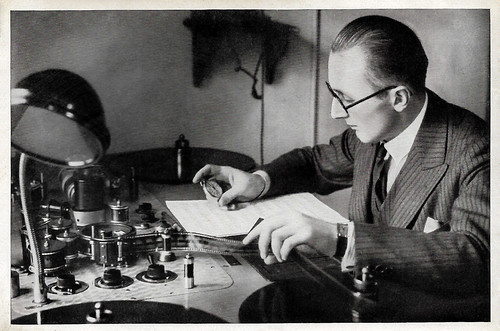
German collectors card in the series 'Vom Werden deutscher Filmkunst - Der Tonfilm', album no. 11, picture no. 18. Photo: Ufa / Ross Verlag. The composer with stopwatch.
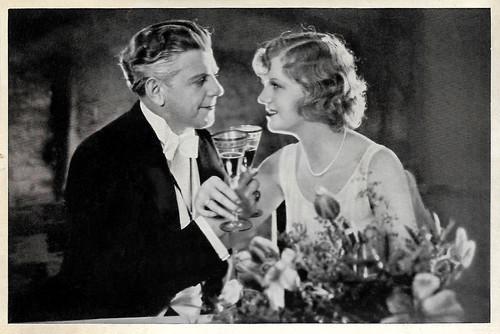
German collectors card in the series 'Vom Werden deutscher Filmkunst - Der Tonfilm', album no. 11, picture no. 20. Photo: Super-Film / Ross Verlag. Walter Janssen and Gretl Theimer in Zwei Herzen im Dreiviertel-Takt/Two Hearts in Waltz Time (Géza von Bolváry, 1930).
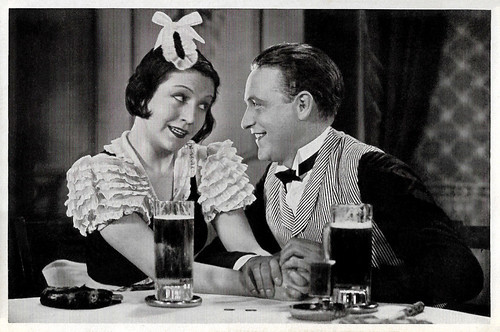
German collectors card in the series 'Vom Werden deutscher Filmkunst - Der Tonfilm', album no. 11, picture no. 23. Photo: Ufa / Ross Verlag. Käthe von Nagy and Willy Fritsch in Ihre Hoheit befiehlt/Her Grace Commands (Hanns Schwarz, 1931).
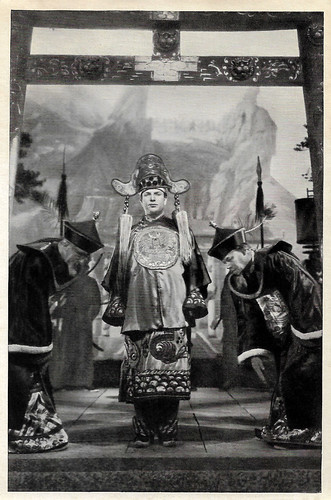
German collectors card in the series 'Vom Werden deutscher Filmkunst - Der Tonfilm', album no. 11, picture no. 25. Photo: Bayerische Filmges. / Ross Verlag. Richard Tauber in Das Land des Lächelns/The Land of Smiles (Max Reichmann, 1930).
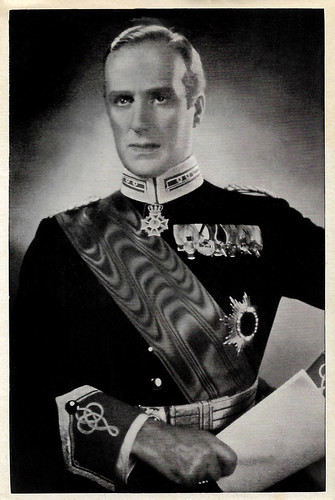
German collectors card in the series 'Vom Werden deutscher Filmkunst - Der Tonfilm', album no. 11, picture no. 28. Photo: Badal-Film / Ross Verlag. Louis Graveure in Ein Walzer für dich/A Waltz for You (Georg Zoch, 1934).
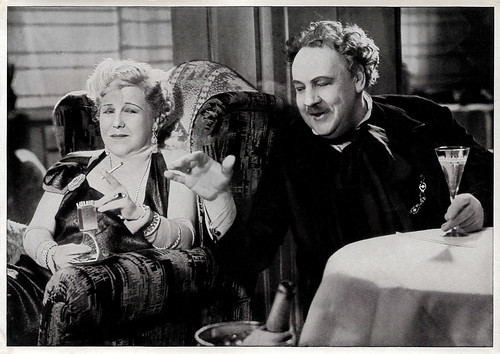
German collectors card in the series 'Vom Werden deutscher Filmkunst - Der Tonfilm', album no. 11, picture no. 30. Photo: Ufa / Ross Verlag. Ida Wüst and Leo Slezak in Freut Euch des Lebens/Enjoy Yourselves (Hans Steinhoff, 1934).
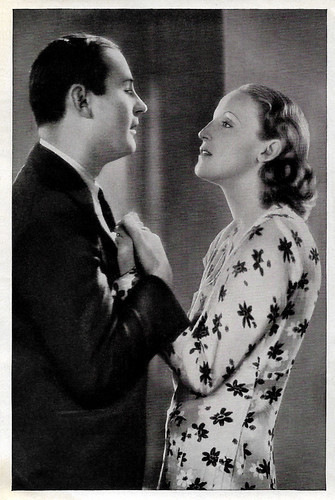
German collectors card in the series 'Vom Werden deutscher Filmkunst - Der Tonfilm', album no. 11, picture no. 31. Photo: Ufa / Ross Verlag. Jan Kiepura and Brigitte Helm in Die singende Stadt/The Singing City (Carmine Gallone, 1930).
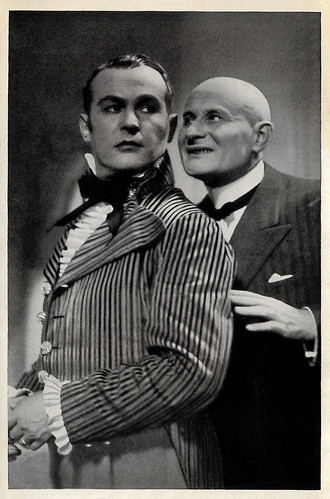
German collectors card in the series 'Vom Werden deutscher Filmkunst - Der Tonfilm', album no. 11, picture no. 32. Photo: Cine-Allianz / Ross Verlag. Jan Kiepura and Julius Falkenstein in Das Lied einer Nacht/The Song of Night (Anatole Litvak, 1932).
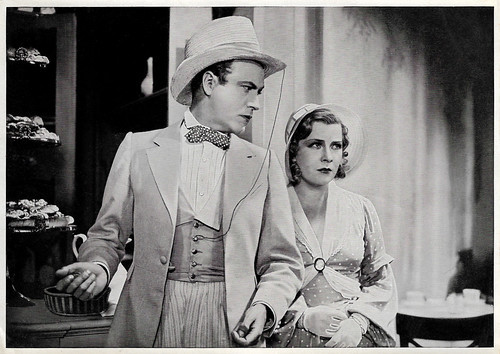
German collectors card in the series 'Vom Werden deutscher Filmkunst - Der Tonfilm', album no. 11, picture no. 34. Photo: Ufa / Ross Verlag. Willy Fritsch and Renate Müller in Walzerkrieg/Waltz War (Ludwig Berger, 1933).
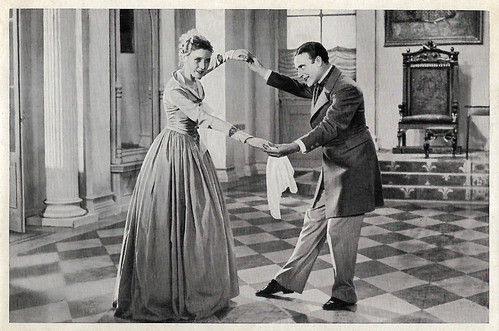
German collectors card in the series 'Vom Werden deutscher Filmkunst - Der Tonfilm', album no. 11, picture no. 35, group 44. Photo: Ufa / Ross Verlag. Willy Fritsch learns the young Queen of England Hanna Waag to waltz in Walzerkrieg/Waltz War (Ludwig Berger, 1933).
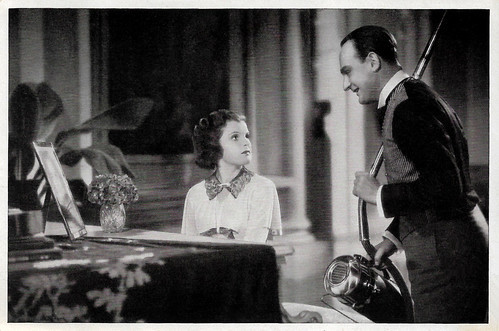
German collectors card in the series 'Vom Werden deutscher Filmkunst - Der Tonfilm', album no. 11, picture no. 36. Photo: Boston-Film / Ross Verlag. Magda Schneider and Willi Forst in Ich kenn' dich nicht und liebe dich/I Don't Know You, But I Love You (Géza von Bolváry, 1934).
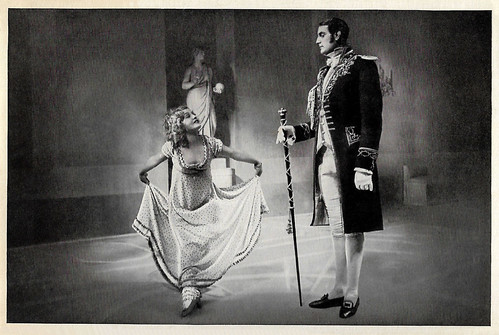
German collectors card in the series 'Vom Werden deutscher Filmkunst - Der Tonfilm', album no. 11, picture no. 39. Photo: Ufa / Ross Verlag. Lilian Harvey in Der Kongress tanzt/The Congress dances (Erik Charell, 1931).
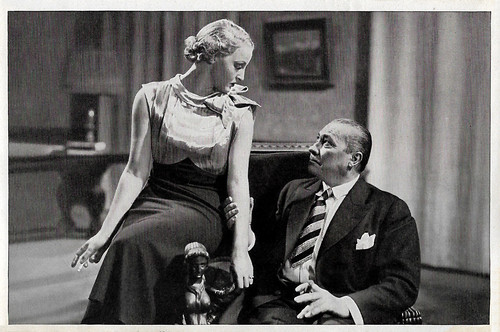
German collectors card in the series 'Vom Werden deutscher Filmkunst - Der Tonfilm', album no. 11, picture no. 41. Photo: Ufa / Ross Verlag. Brigitte Helm and Paul Wegener in Inge und die Millionen/Inge and the Millions (Erich Engel, 1933).
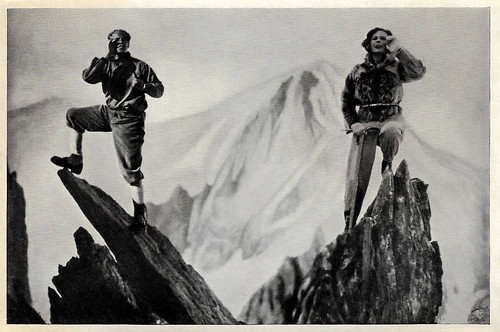
German collectors card in the series 'Vom Werden deutscher Filmkunst - Der Tonfilm', album no. 11, picture no. 42. Photo: Aafa / Ross Verlag. Sepp Rist and Leni Riefenstahl in Stürme über dem Mont Blanc/Storm Over Mont Blanc (Arnold Fanck, 1930).
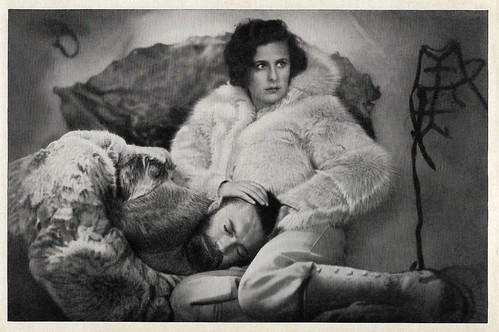
German collectors card in the series 'Vom Werden deutscher Filmkunst - Der Tonfilm', album no. 11, picture no. 43, group 44. Photo: Ufa / Ross Verlag. Leni Riefenstahl and Gustav Diessl in S.O.S. Eisberg/S.O.S. Iceberg (Arnold Fanck, 1933).
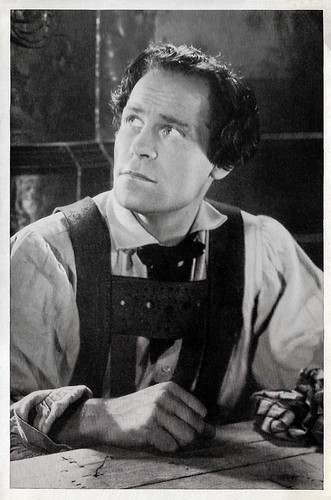
German collectors card in the series 'Vom Werden deutscher Filmkunst - Der Tonfilm', album no. 11, picture no. 44. Photo: Cine-Allianz / Ross Verlag. Sepp Rist in Der ewige Traum/The Eternal Dream (Arnold Fanck, 1934).
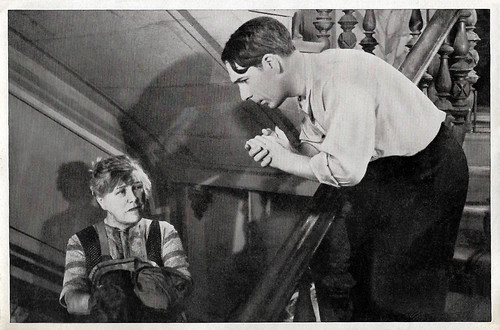
German collectors card in the series 'Vom Werden deutscher Filmkunst - Der Tonfilm', album no. 11, picture no. 47. Photo: Froelich-Film / Ross Verlag. Ida Wüst and Paul Kemp in Mieter Schulze gegen alle/Tenant Schulze against everyone (Carl Froelich, 1932).
To be continued.

German collectors card in the series 'Vom Werden deutscher Filmkunst - Der Tonfilm', album no. 11, picture no. 4. Photo: Ufa / Ross Verlag. Dita Parlo and Willy Fritsch in Melodie des Herzens/Melody of the Heart (Hanns Schwarz, 1929).

German collectors card in the series 'Vom Werden deutscher Filmkunst - Der Tonfilm', album no. 11, picture no. 6, group 44. Photo: Ufa / Ross Verlag. Gustav Fröhlich and Liane Haid in Die unsterbliche Lump/The Immortal Vagabond (Gustav Ucicky, Joe May, 1930).

German collectors card in the series 'Vom Werden deutscher Filmkunst - Der Tonfilm', album no. 11, picture no. 12. Photo: Ufa / Ross Verlag. Caption: Karl Hoffmann hüllt sich und seine summende Kamera in dicke Tücher ein. (Karl Hoffmann wraps himself and his buzzing camera in thick cloths.)

German collectors card in the series 'Vom Werden deutscher Filmkunst - Der Tonfilm', album no. 11, picture no. 16. Photo: Ufa / Ross Verlag. Caption: Ufa-Gelände Neubabelsberg, mit mehr als 430000 qm gesamtfläche und 11 grossen Atelierhallen der grösste Atelierbetrieb in ganz Europa. (The Ufa site Neubabelsberg, with a total area of more than 430,000 square meters and 11 big studio halls, the largest film studio in Europe.)

German collectors card in the series 'Vom Werden deutscher Filmkunst - Der Tonfilm', album no. 11, picture no. 18. Photo: Ufa / Ross Verlag. The composer with stopwatch.

German collectors card in the series 'Vom Werden deutscher Filmkunst - Der Tonfilm', album no. 11, picture no. 20. Photo: Super-Film / Ross Verlag. Walter Janssen and Gretl Theimer in Zwei Herzen im Dreiviertel-Takt/Two Hearts in Waltz Time (Géza von Bolváry, 1930).

German collectors card in the series 'Vom Werden deutscher Filmkunst - Der Tonfilm', album no. 11, picture no. 23. Photo: Ufa / Ross Verlag. Käthe von Nagy and Willy Fritsch in Ihre Hoheit befiehlt/Her Grace Commands (Hanns Schwarz, 1931).

German collectors card in the series 'Vom Werden deutscher Filmkunst - Der Tonfilm', album no. 11, picture no. 25. Photo: Bayerische Filmges. / Ross Verlag. Richard Tauber in Das Land des Lächelns/The Land of Smiles (Max Reichmann, 1930).

German collectors card in the series 'Vom Werden deutscher Filmkunst - Der Tonfilm', album no. 11, picture no. 28. Photo: Badal-Film / Ross Verlag. Louis Graveure in Ein Walzer für dich/A Waltz for You (Georg Zoch, 1934).

German collectors card in the series 'Vom Werden deutscher Filmkunst - Der Tonfilm', album no. 11, picture no. 30. Photo: Ufa / Ross Verlag. Ida Wüst and Leo Slezak in Freut Euch des Lebens/Enjoy Yourselves (Hans Steinhoff, 1934).

German collectors card in the series 'Vom Werden deutscher Filmkunst - Der Tonfilm', album no. 11, picture no. 31. Photo: Ufa / Ross Verlag. Jan Kiepura and Brigitte Helm in Die singende Stadt/The Singing City (Carmine Gallone, 1930).

German collectors card in the series 'Vom Werden deutscher Filmkunst - Der Tonfilm', album no. 11, picture no. 32. Photo: Cine-Allianz / Ross Verlag. Jan Kiepura and Julius Falkenstein in Das Lied einer Nacht/The Song of Night (Anatole Litvak, 1932).

German collectors card in the series 'Vom Werden deutscher Filmkunst - Der Tonfilm', album no. 11, picture no. 34. Photo: Ufa / Ross Verlag. Willy Fritsch and Renate Müller in Walzerkrieg/Waltz War (Ludwig Berger, 1933).

German collectors card in the series 'Vom Werden deutscher Filmkunst - Der Tonfilm', album no. 11, picture no. 35, group 44. Photo: Ufa / Ross Verlag. Willy Fritsch learns the young Queen of England Hanna Waag to waltz in Walzerkrieg/Waltz War (Ludwig Berger, 1933).

German collectors card in the series 'Vom Werden deutscher Filmkunst - Der Tonfilm', album no. 11, picture no. 36. Photo: Boston-Film / Ross Verlag. Magda Schneider and Willi Forst in Ich kenn' dich nicht und liebe dich/I Don't Know You, But I Love You (Géza von Bolváry, 1934).

German collectors card in the series 'Vom Werden deutscher Filmkunst - Der Tonfilm', album no. 11, picture no. 39. Photo: Ufa / Ross Verlag. Lilian Harvey in Der Kongress tanzt/The Congress dances (Erik Charell, 1931).

German collectors card in the series 'Vom Werden deutscher Filmkunst - Der Tonfilm', album no. 11, picture no. 41. Photo: Ufa / Ross Verlag. Brigitte Helm and Paul Wegener in Inge und die Millionen/Inge and the Millions (Erich Engel, 1933).

German collectors card in the series 'Vom Werden deutscher Filmkunst - Der Tonfilm', album no. 11, picture no. 42. Photo: Aafa / Ross Verlag. Sepp Rist and Leni Riefenstahl in Stürme über dem Mont Blanc/Storm Over Mont Blanc (Arnold Fanck, 1930).

German collectors card in the series 'Vom Werden deutscher Filmkunst - Der Tonfilm', album no. 11, picture no. 43, group 44. Photo: Ufa / Ross Verlag. Leni Riefenstahl and Gustav Diessl in S.O.S. Eisberg/S.O.S. Iceberg (Arnold Fanck, 1933).

German collectors card in the series 'Vom Werden deutscher Filmkunst - Der Tonfilm', album no. 11, picture no. 44. Photo: Cine-Allianz / Ross Verlag. Sepp Rist in Der ewige Traum/The Eternal Dream (Arnold Fanck, 1934).

German collectors card in the series 'Vom Werden deutscher Filmkunst - Der Tonfilm', album no. 11, picture no. 47. Photo: Froelich-Film / Ross Verlag. Ida Wüst and Paul Kemp in Mieter Schulze gegen alle/Tenant Schulze against everyone (Carl Froelich, 1932).
To be continued.
Published on March 14, 2020 23:00
March 13, 2020
Five More Filmshots by Film Weekly
Today, EFSP has the second post with five series of Filmshots cards, produced as a supplement for the British magazine Film Weekly. Each series presents a Hollywood film of the early 1930s, the pictures are in black and white and a few basic credits are added: the (British) film title, the two main actors and the studio. These five Filmshots series are from the collection of Ivo Blom.
A Farewell to Arms (1932)
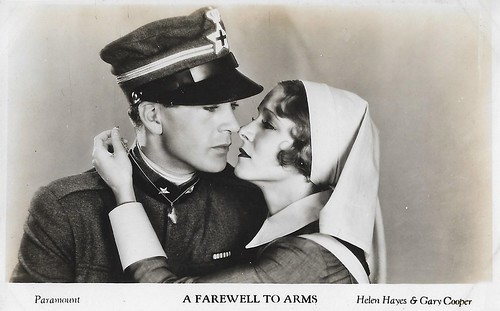
British postcard by Film Weekly. Photo: Paramount. Gary Cooper and Helen Hayes in A Farewell to Arms (Frank Borzage, 1932), based on Ernest Hemingway's homonymous novel (1929).
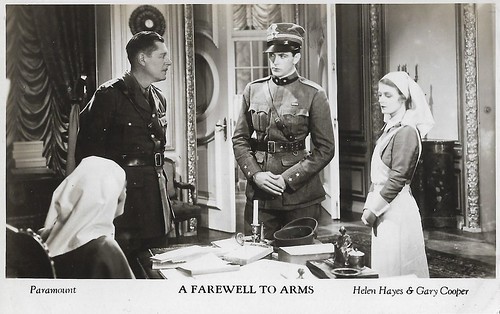
British postcard by Film Weekly. Photo: Paramount. Gary Cooper in A Farewell to Arms (Frank Borzage, 1932). The woman on the right is not Helen Hayes. The man on the left is Gilbert Emery (British major), the woman on the left is Blanche Friderici (Head nurse).
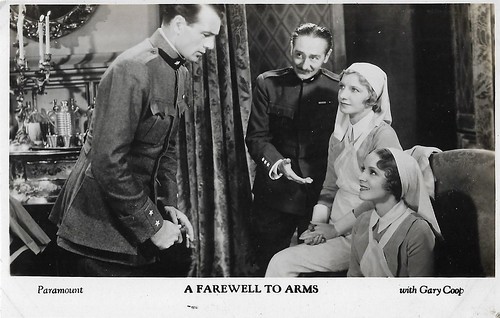
British postcard by Film Weekly. Photo: Paramount. Gary Cooper , Adolphe Menjou , Mary Philips, and Helen Hayes in A Farewell to Arms (Frank Borzage, 1932).
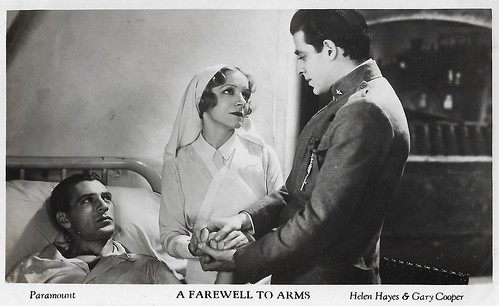
British postcard by Film Weekly. Photo: Paramount. Gary Cooper , Helen Hayes, and Jack La Rue in A Farewell to Arms (Frank Borzage, 1932).
A Farewell to Arms (Frank Borzage, 1932) is the first of the three screen adaptations of Ernest Hemingway's homonymous novel from 1929. Gary Cooper , and Helen Hayes star as the American ambulance driver Lt. Fredric Henry and the English nurse Catherine Barkley. The action takes place in Italy during World War I, Henry and Barkley fall in love and will stop at nothing to be together. The film also analyses Lt. Henry's feelings on war and the purpose of fighting.
Adolphe Menjou replete with Italian accent plays Cooper's friend and romantic rival, Major Rinaldi. In the supporting cast are also Mary Phillips as Helen Ferguson, a nurse and Catherine's closest friend who objects to her continued romance with the young American, Jack LaRue as the soft-spoken Italian priest, and Blanche Frederici as the stern head nurse. The film is sublimely photographed by Charles Lang who deservedly won an Oscar.
A Farewell to Arms was a highly popular war drama in its day. The film concentrates more on the relationship between the lieutenant and the nurse than on the soldiers on the battlefield. The film earned an Academy Award nomination for Best Picture of 1932-1933. Director Frank Borzage brings out the tenderness and simplicity of the young couple in love as he had done earlier in a series of classic films starring Janet Gaynor and Charles Farrell at Fox Studios.
Clear All Wires! (1933)
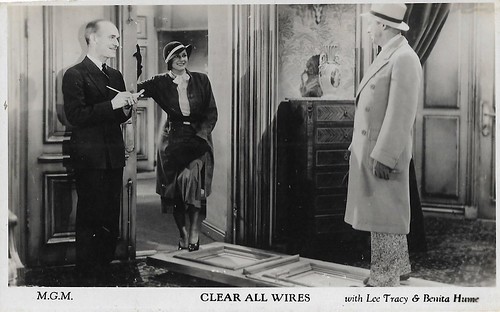
British postcard by Film Weekly. Photo: MGM. Lee Tracy and Benita Hume in Clear All Wires! (George Hill, 1933), here also with James Gleason.
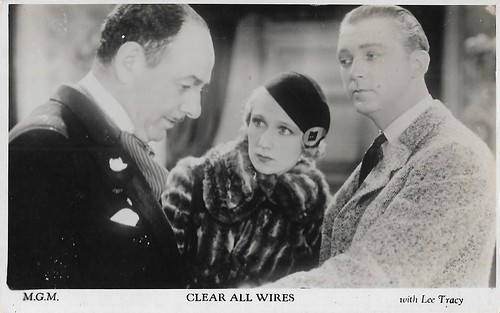
British postcard by Film Weekly. Photo: MGM. Lee Tracy in Clear All Wires! (George Hill, 1933). The woman in this card may be Una Merkel, the man on the left could be Guy Usher.
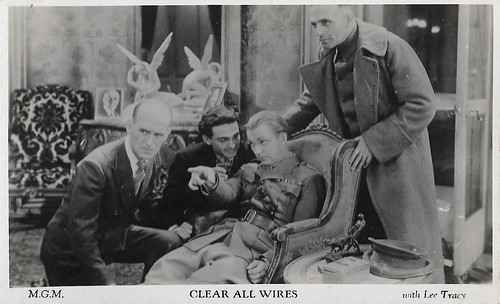
British postcard by Film Weekly. Photo: MGM. Lee Tracy in Clear All Wires! (George Hill, 1933). The man on the left here is James Gleason. The man behind the chair could C. Henry Gordon.
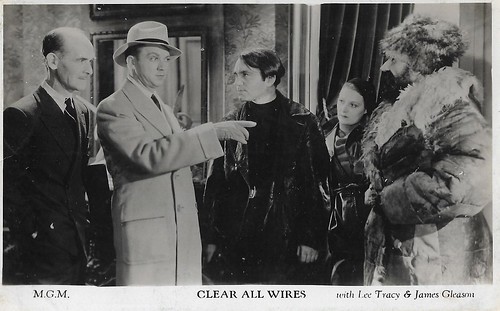
British postcard by Film Weekly. Photo: MGM. Lee Tracy in Clear All Wires! (George Hill, 1933). Left of Tracy stands James Gleason. The woman is Benita Hume.
Lee Tracy plays in Clear All Wires! (George Hill, 1933) the fast-talking Buckley Joyce Thomas, an unethical reporter who manipulates the news for his own benefit as much as he reports it. When he is in Paris to get a medal for being rescued from his alleged kidnappers, he finds that his boss, Stevens (Guy Usher), at the Chicago Globe is going with his old gal Dolly (Una Merkel). When Stevens learns that Dolly is staying with Buckley in Moscow, he fires Buckley. To get his job back, Buckley and Lefty (James Gleason) stage a great news story about the shooting of the last Romanoff, Prince Alexander, played by Eugene Sigaloff. but the plan backfires and they are now in line to be shot by the Commissar (C. Henry Gordon).
The film was based on a popular Broadway play by Bella and Samuel Spewack. In Encyclopedia of Journalists on Film, Richard Ness draws an interesting relationship with Orson Welles' later film Citizen Kane (1941), referring to the subplot of the operatic ambitions of the shrill-voiced mistress Dolly, even practicing the same Aria as in Citizen Kane. While in Welles' film the character is called Susan Alexander Kane, Lefty tells Buckley Dolly got a call from Mr. Alexander. Another scene in which Buckley meets Stalin and lights the dictator's pipe foreshadows a similar scene between Kane and Hitler in the staged newsreel in the film.
Melody Cruise (1933)
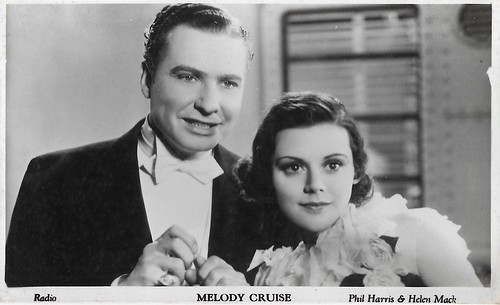
British postcard by Film Weekly. Photo: RKO Radio. Phil Harris, and Helen Mack in Melody Cruise (Mark Sandrich, 1933).
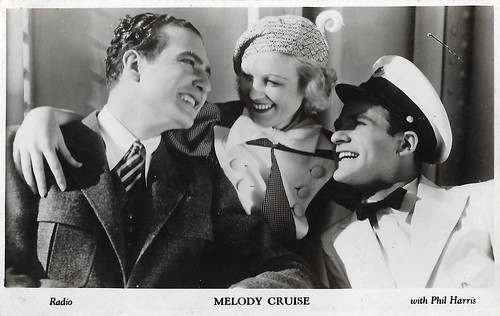
British postcard by Film Weekly. Photo: RKO Radio. Phil Harris, Chick Chandler and probably Greta Nissen in Melody Cruise (Mark Sandrich, 1933).
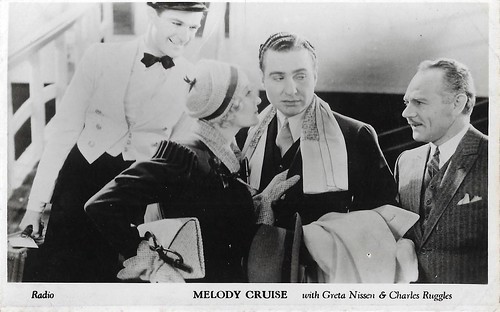
British postcard by Film Weekly. Photo: RKO Radio. Greta Nissen , and Charles Ruggles in Melody Cruise (Mark Sandrich, 1933).
![Phil Harris, Chick Chandler and [Greta Nissen] in Melody Cruise. RKO. Film Weekly](https://i.gr-assets.com/images/S/compressed.photo.goodreads.com/hostedimages/1584177470i/29104483.jpg)
British postcard by Film Weekly. Photo: RKO Radio. Phil Harris, Greta Nissen , and Chick Chandler in Melody Cruise (Mark Sandrich, 1933).
Melody Cruise (Mark Sandrich, 1933) is a pre-Code romantic musical comedy about a bachelor millionaire, Alan Chandler (Phil Harris), hunted by women aboard a cruise liner. Charles Ruggles plays his best friend and womanizer Pete, Greta Nissen plays Elsa von Rader, Alan's mundane friend, Chick Chandler plays the steward Hickey whom Pete has bribed to prevent Alan from marrying, and Helen Mack is Laurie Marlowe, Alan's new friend.
After "wintering" in New York, Pasadena businessman Pete Wells prepares for his ocean voyage home by throwing a wild party in his stateroom. While drunk, Pete signs a letter written by his best friend, playboy Alan Chandler, in which his various adulterous affairs are described in detail. Determined to remain a bachelor, Alan has arranged for the letter to be sent to Pete's wife Grace but has instructed that it not be opened until he marries.
The next morning, after the letter has been mailed and the ship is in mid-ocean, Pete discovers Zoe and Vera, two of his party-goers, stranded in his stateroom. To keep the women safely in his cabin, Pete bribes steward Hickey to steal their clothes. He then hires Hickey to discourage the blossoming romance between Alan and German beauty Elsa Von Rader, fearful that it may lead to marriage and, consequently, the opening of the letter. Soon after, Pete runs into a friend of his wife, Miss Potts, a principal who is traveling with teacher Laurie Marlowe. When Pete and Miss Potts encounter the half-dressed Zoe and Vera on the ship's deck, Pete tells her that the young women are his nieces. While Miss Potts and Pete's "nieces" become acquainted, Alan accidentally waltzes into Laurie's stateroom and begins to romance her. Although attracted to the polished playboy, Laurie dismisses him, and he continues his affair with Elsa until the machinations of Hickey bring him back to Laurie.
Gabriel Over the White House (1933)
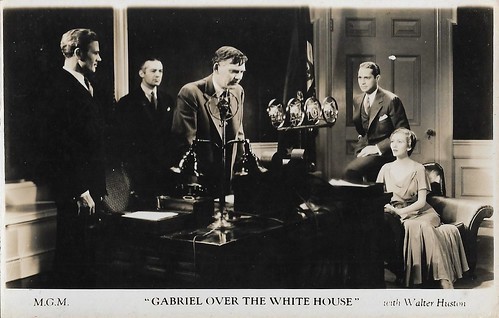
British postcard by Film Weekly. Photo: MGM. Walter Huston, Franchot Tone, and Karen Morley in Gabriel Over the White House (Gregory La Cava, 1933).
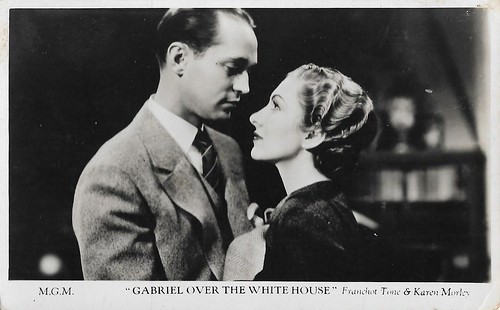
British postcard by Film Weekly. Photo: MGM. Franchot Tone, and Karen Morley in Gabriel Over the White House (Gregory La Cava, 1933).
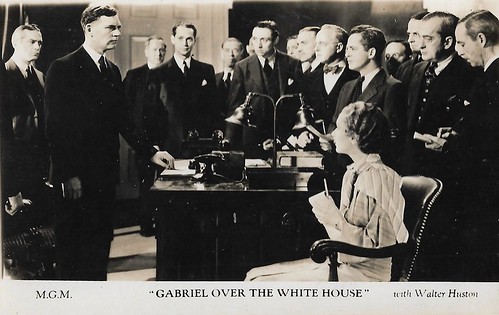
British postcard by Film Weekly. Photo: MGM. Walter Huston (left), Franchot Tone (centre), and Karen Morley (sitting) in Gabriel Over the White House (Gregory La Cava, 1933). The fourth card in this series still lacks.
Gabriel Over the White House (Gregory La Cava, 1933) was a controversial film on a corrupt new American president. Judd Hammond (Walter Huston) has taken his mistress Pendola (Karen Morley) to his office and neglects the worries of his people: hunger, unemployment, and gangsterism. Because of a car accident, he gets into a coma and when awakened, he has become a totally different person. He wants an agreement with protesting workers marching up to Washington and fires his corrupt cabinet. He manages to get plenipotentiary powers. He helps farmers and ends Prohibition. Together with his secretary Beekman (Franchot Tone), he makes a quick, drastic end to the racketing of Nick Diamond (C. Henry Gordon). He even manages other nations to pay back their war debts to the US, by threatening them with arms. After an international agreement is signed, he collapses and dies.
Gabriel Over the White House was made during a special moment in time. Producer Walter Wanger conceived of it as Rooseveltian vehicle, right from the start, against the wishes of Louis B. Mayer, a stark Republican, but backed by William Randolph Hearst, who not only was a big Roosevelt backer but supposedly also wrote part of the speech President Hammond gives in the film. Mayer was furious when during a preview he noticed that Hammond's presidency changes into dictatorship, but the film was released end of March 1933, about four weeks after Roosevelt had been inaugurated as president.
When the film came out, Mussolini, Stalin, and Hitler ruled their countries as dictators - Hitler only very recently. Of course, Roosevelt implemented his New Deal without dictatorship. In 1932 marches by WWI veterans and the unemployed were really taking place, while Al Capone went to prison - for tax evasion. In December 1933 Prohibition would be repealed.
Blonde Bombshell (1933)
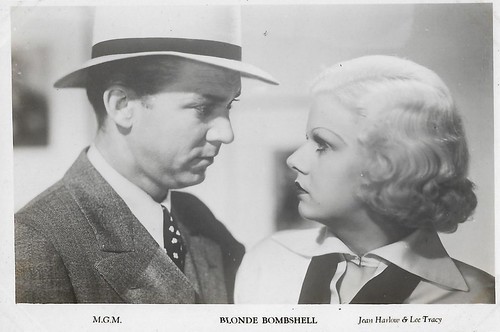
British postcard by Film Weekly. Photo: MGM. Jean Harlow and Lee Tracy in Blonde Bombshell/Bombshell (Victor Fleming, 1933).
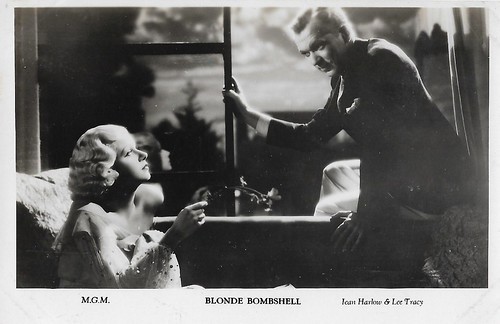
British postcard by Film Weekly. Photo: MGM. Jean Harlow and Lee Tracy in Blonde Bombshell/Bombshell (Victor Fleming, 1933).
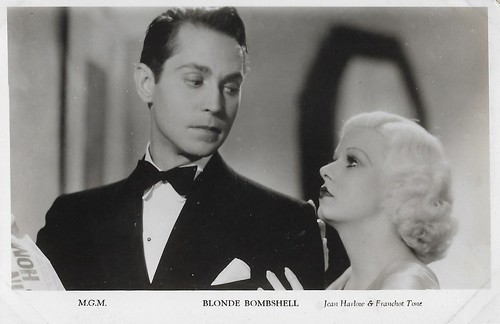
British postcard by Film Weekly. Photo: MGM. Franchot Tone and Jean Harlow in Blonde Bombshell/Bombshell (Victor Fleming, 1933).
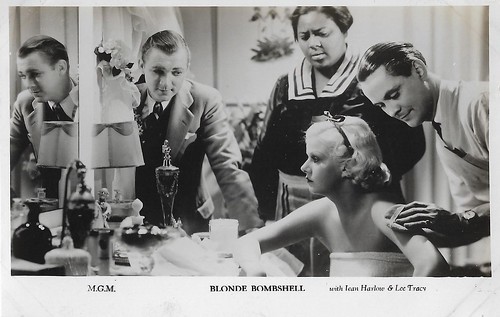
British postcard by Film Weekly. Photo: MGM. Jean Harlow , Louise Beavers, and Lee Tracy in Blonde Bombshell/Bombshell (Victor Fleming, 1933).
In the pre-Code screwball comedy Blonde Bombshell/ Bombshell (Victor Fleming, 1933), movie star Lola Burns ( Jean Harlow ) is angry with her studio publicist E.J. "Space" Hanlon (Lee Tracy), who feeds the press with endless stories about her greatness. Lola's family and staff are another cause of distress for her, as everybody is always trying to get money from the actress. All Burns really wants is to live a normal life and prove to the public that she's not a sexy vamp, but a proper lady. She tries to adopt a baby, but Hanlon, who secretly loves her, thwarts all her plans.
Burns decides she can't stand any more of such a life and flees. Far from the movie fluff, she meets wealthy and romantic Gifford Middleton (Franchot Tone), who hates the movies and therefore has never heard about Lola Burns and her bad press. They soon fall in love, and Gifford proposes marriage. Burns is to meet her fiancé's parents, but everything collapses when Hanlon, together with Burns' family, finds her and tells the Middletons the truth. Burns feels hurt by the rude way Gifford and his parents dump her and accepts Hanlon's suggestion to return to Hollywood with no regrets. She does not know that the three Middletons were all actors hired by Hanlon himself.
Sources: a.o. Wikipedia and IMDb
A Farewell to Arms (1932)

British postcard by Film Weekly. Photo: Paramount. Gary Cooper and Helen Hayes in A Farewell to Arms (Frank Borzage, 1932), based on Ernest Hemingway's homonymous novel (1929).

British postcard by Film Weekly. Photo: Paramount. Gary Cooper in A Farewell to Arms (Frank Borzage, 1932). The woman on the right is not Helen Hayes. The man on the left is Gilbert Emery (British major), the woman on the left is Blanche Friderici (Head nurse).

British postcard by Film Weekly. Photo: Paramount. Gary Cooper , Adolphe Menjou , Mary Philips, and Helen Hayes in A Farewell to Arms (Frank Borzage, 1932).

British postcard by Film Weekly. Photo: Paramount. Gary Cooper , Helen Hayes, and Jack La Rue in A Farewell to Arms (Frank Borzage, 1932).
A Farewell to Arms (Frank Borzage, 1932) is the first of the three screen adaptations of Ernest Hemingway's homonymous novel from 1929. Gary Cooper , and Helen Hayes star as the American ambulance driver Lt. Fredric Henry and the English nurse Catherine Barkley. The action takes place in Italy during World War I, Henry and Barkley fall in love and will stop at nothing to be together. The film also analyses Lt. Henry's feelings on war and the purpose of fighting.
Adolphe Menjou replete with Italian accent plays Cooper's friend and romantic rival, Major Rinaldi. In the supporting cast are also Mary Phillips as Helen Ferguson, a nurse and Catherine's closest friend who objects to her continued romance with the young American, Jack LaRue as the soft-spoken Italian priest, and Blanche Frederici as the stern head nurse. The film is sublimely photographed by Charles Lang who deservedly won an Oscar.
A Farewell to Arms was a highly popular war drama in its day. The film concentrates more on the relationship between the lieutenant and the nurse than on the soldiers on the battlefield. The film earned an Academy Award nomination for Best Picture of 1932-1933. Director Frank Borzage brings out the tenderness and simplicity of the young couple in love as he had done earlier in a series of classic films starring Janet Gaynor and Charles Farrell at Fox Studios.
Clear All Wires! (1933)

British postcard by Film Weekly. Photo: MGM. Lee Tracy and Benita Hume in Clear All Wires! (George Hill, 1933), here also with James Gleason.

British postcard by Film Weekly. Photo: MGM. Lee Tracy in Clear All Wires! (George Hill, 1933). The woman in this card may be Una Merkel, the man on the left could be Guy Usher.

British postcard by Film Weekly. Photo: MGM. Lee Tracy in Clear All Wires! (George Hill, 1933). The man on the left here is James Gleason. The man behind the chair could C. Henry Gordon.

British postcard by Film Weekly. Photo: MGM. Lee Tracy in Clear All Wires! (George Hill, 1933). Left of Tracy stands James Gleason. The woman is Benita Hume.
Lee Tracy plays in Clear All Wires! (George Hill, 1933) the fast-talking Buckley Joyce Thomas, an unethical reporter who manipulates the news for his own benefit as much as he reports it. When he is in Paris to get a medal for being rescued from his alleged kidnappers, he finds that his boss, Stevens (Guy Usher), at the Chicago Globe is going with his old gal Dolly (Una Merkel). When Stevens learns that Dolly is staying with Buckley in Moscow, he fires Buckley. To get his job back, Buckley and Lefty (James Gleason) stage a great news story about the shooting of the last Romanoff, Prince Alexander, played by Eugene Sigaloff. but the plan backfires and they are now in line to be shot by the Commissar (C. Henry Gordon).
The film was based on a popular Broadway play by Bella and Samuel Spewack. In Encyclopedia of Journalists on Film, Richard Ness draws an interesting relationship with Orson Welles' later film Citizen Kane (1941), referring to the subplot of the operatic ambitions of the shrill-voiced mistress Dolly, even practicing the same Aria as in Citizen Kane. While in Welles' film the character is called Susan Alexander Kane, Lefty tells Buckley Dolly got a call from Mr. Alexander. Another scene in which Buckley meets Stalin and lights the dictator's pipe foreshadows a similar scene between Kane and Hitler in the staged newsreel in the film.
Melody Cruise (1933)

British postcard by Film Weekly. Photo: RKO Radio. Phil Harris, and Helen Mack in Melody Cruise (Mark Sandrich, 1933).

British postcard by Film Weekly. Photo: RKO Radio. Phil Harris, Chick Chandler and probably Greta Nissen in Melody Cruise (Mark Sandrich, 1933).

British postcard by Film Weekly. Photo: RKO Radio. Greta Nissen , and Charles Ruggles in Melody Cruise (Mark Sandrich, 1933).
![Phil Harris, Chick Chandler and [Greta Nissen] in Melody Cruise. RKO. Film Weekly](https://i.gr-assets.com/images/S/compressed.photo.goodreads.com/hostedimages/1584177470i/29104483.jpg)
British postcard by Film Weekly. Photo: RKO Radio. Phil Harris, Greta Nissen , and Chick Chandler in Melody Cruise (Mark Sandrich, 1933).
Melody Cruise (Mark Sandrich, 1933) is a pre-Code romantic musical comedy about a bachelor millionaire, Alan Chandler (Phil Harris), hunted by women aboard a cruise liner. Charles Ruggles plays his best friend and womanizer Pete, Greta Nissen plays Elsa von Rader, Alan's mundane friend, Chick Chandler plays the steward Hickey whom Pete has bribed to prevent Alan from marrying, and Helen Mack is Laurie Marlowe, Alan's new friend.
After "wintering" in New York, Pasadena businessman Pete Wells prepares for his ocean voyage home by throwing a wild party in his stateroom. While drunk, Pete signs a letter written by his best friend, playboy Alan Chandler, in which his various adulterous affairs are described in detail. Determined to remain a bachelor, Alan has arranged for the letter to be sent to Pete's wife Grace but has instructed that it not be opened until he marries.
The next morning, after the letter has been mailed and the ship is in mid-ocean, Pete discovers Zoe and Vera, two of his party-goers, stranded in his stateroom. To keep the women safely in his cabin, Pete bribes steward Hickey to steal their clothes. He then hires Hickey to discourage the blossoming romance between Alan and German beauty Elsa Von Rader, fearful that it may lead to marriage and, consequently, the opening of the letter. Soon after, Pete runs into a friend of his wife, Miss Potts, a principal who is traveling with teacher Laurie Marlowe. When Pete and Miss Potts encounter the half-dressed Zoe and Vera on the ship's deck, Pete tells her that the young women are his nieces. While Miss Potts and Pete's "nieces" become acquainted, Alan accidentally waltzes into Laurie's stateroom and begins to romance her. Although attracted to the polished playboy, Laurie dismisses him, and he continues his affair with Elsa until the machinations of Hickey bring him back to Laurie.
Gabriel Over the White House (1933)

British postcard by Film Weekly. Photo: MGM. Walter Huston, Franchot Tone, and Karen Morley in Gabriel Over the White House (Gregory La Cava, 1933).

British postcard by Film Weekly. Photo: MGM. Franchot Tone, and Karen Morley in Gabriel Over the White House (Gregory La Cava, 1933).

British postcard by Film Weekly. Photo: MGM. Walter Huston (left), Franchot Tone (centre), and Karen Morley (sitting) in Gabriel Over the White House (Gregory La Cava, 1933). The fourth card in this series still lacks.
Gabriel Over the White House (Gregory La Cava, 1933) was a controversial film on a corrupt new American president. Judd Hammond (Walter Huston) has taken his mistress Pendola (Karen Morley) to his office and neglects the worries of his people: hunger, unemployment, and gangsterism. Because of a car accident, he gets into a coma and when awakened, he has become a totally different person. He wants an agreement with protesting workers marching up to Washington and fires his corrupt cabinet. He manages to get plenipotentiary powers. He helps farmers and ends Prohibition. Together with his secretary Beekman (Franchot Tone), he makes a quick, drastic end to the racketing of Nick Diamond (C. Henry Gordon). He even manages other nations to pay back their war debts to the US, by threatening them with arms. After an international agreement is signed, he collapses and dies.
Gabriel Over the White House was made during a special moment in time. Producer Walter Wanger conceived of it as Rooseveltian vehicle, right from the start, against the wishes of Louis B. Mayer, a stark Republican, but backed by William Randolph Hearst, who not only was a big Roosevelt backer but supposedly also wrote part of the speech President Hammond gives in the film. Mayer was furious when during a preview he noticed that Hammond's presidency changes into dictatorship, but the film was released end of March 1933, about four weeks after Roosevelt had been inaugurated as president.
When the film came out, Mussolini, Stalin, and Hitler ruled their countries as dictators - Hitler only very recently. Of course, Roosevelt implemented his New Deal without dictatorship. In 1932 marches by WWI veterans and the unemployed were really taking place, while Al Capone went to prison - for tax evasion. In December 1933 Prohibition would be repealed.
Blonde Bombshell (1933)

British postcard by Film Weekly. Photo: MGM. Jean Harlow and Lee Tracy in Blonde Bombshell/Bombshell (Victor Fleming, 1933).

British postcard by Film Weekly. Photo: MGM. Jean Harlow and Lee Tracy in Blonde Bombshell/Bombshell (Victor Fleming, 1933).

British postcard by Film Weekly. Photo: MGM. Franchot Tone and Jean Harlow in Blonde Bombshell/Bombshell (Victor Fleming, 1933).

British postcard by Film Weekly. Photo: MGM. Jean Harlow , Louise Beavers, and Lee Tracy in Blonde Bombshell/Bombshell (Victor Fleming, 1933).
In the pre-Code screwball comedy Blonde Bombshell/ Bombshell (Victor Fleming, 1933), movie star Lola Burns ( Jean Harlow ) is angry with her studio publicist E.J. "Space" Hanlon (Lee Tracy), who feeds the press with endless stories about her greatness. Lola's family and staff are another cause of distress for her, as everybody is always trying to get money from the actress. All Burns really wants is to live a normal life and prove to the public that she's not a sexy vamp, but a proper lady. She tries to adopt a baby, but Hanlon, who secretly loves her, thwarts all her plans.
Burns decides she can't stand any more of such a life and flees. Far from the movie fluff, she meets wealthy and romantic Gifford Middleton (Franchot Tone), who hates the movies and therefore has never heard about Lola Burns and her bad press. They soon fall in love, and Gifford proposes marriage. Burns is to meet her fiancé's parents, but everything collapses when Hanlon, together with Burns' family, finds her and tells the Middletons the truth. Burns feels hurt by the rude way Gifford and his parents dump her and accepts Hanlon's suggestion to return to Hollywood with no regrets. She does not know that the three Middletons were all actors hired by Hanlon himself.
Sources: a.o. Wikipedia and IMDb
Published on March 13, 2020 23:00
March 12, 2020
Betty Compson
Betty Compson (1897-1974) was an American actress and film producer, who peaked in silent cinema and early talkies. She is best known for her performances as a suicidal prostitute rescued by a stoker (George Bancroft) in Joseph Von Sternberg's The Docks of New York (1928), and as the manipulative carnival girl Carrie in the part-talkie The Barker (1928), the latter earning her a nomination for the Academy Award for Best Actress.
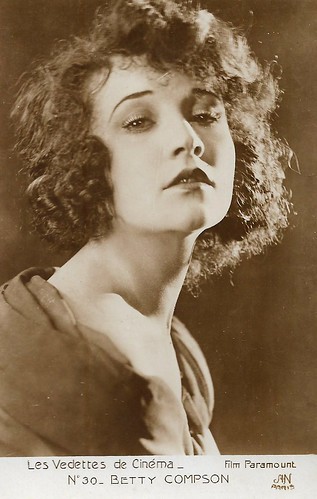
French postcard by A.N., Paris in the 'Les vedettes de cinéma' series, no. 30. Photo: Film Paramount.
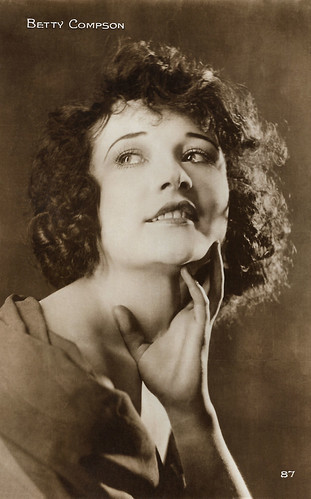
French postcard by Cinémagazine-Edition, no. 87.
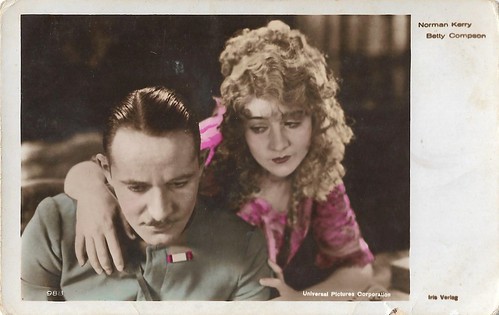
Austrian postcard by Iris Verlag, no. 988. Photo: Universal Pictures Corporation. Betty Compson and Norman Kerry in Love Me and the World Is Mine (Ewald André Dupont, 1927).
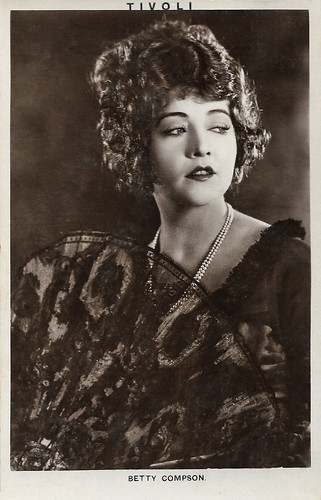
British postcard in the Picturegoer Series, London, no. 196. Betty Compson in The Palace of Pleasure (Emmett J. Flynn, 1926) or in The Belle of Broadway (Harry O. Hoyt, 1926). Caption: Tivoli.
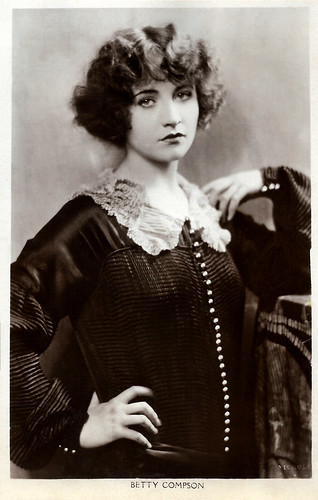
British postcard in the Picturegoer Series, London, no. 98. Photo: Nicholas (?).
The Prettiest Girl in Pictures
Betty Compson was born Eleanor Luicime Compson in 1897 in Beaver, Utah at a mining camp. She was the daughter of Virgil K. Compson and Mary Elizabeth Rauscher. Her father was a mining engineer, a gold prospector, and a grocery store proprietor, and her mother was a maid in homes and in a hotel. A few months after she was born, her father seemingly deserted the family for the Klondike gold strike. As it turned out, he made $25,000 - a small fortune in today's terms - and returned to the family.
Compson graduated from Salt Lake High School. Her father died when she was young and at 16 years old, she obtained employment as a violinist at a vaudeville theatre in Salt Lake City for $15 a week. Following that, she went on tour, with her mother, with an act called 'the Vagabond Violinist'.
In 1916, she appeared on the Alexander Pantages Theatre Circuit, again doing her violin solo vaudeville routine. There, the 18-year-old Compson was discovered by Hollywood producer Al Christie and she signed a contract with him. Christie quickly changed her stage name from Eleanor to Betty.
Her first silent film was the short comedy Wanted, a Leading Lady (Al Christie, 1916), starring Eddie Lyons. The following years, she appeared in many one-reel and two-reel slapstick comedies, frequently paired with Roscoe 'Fatty' Arbuckle . In 1916, she made 25 films - all of them were short comedies with the exception of one feature, Almost a Widow (Horace Davey, 1916). She continued making numerous short comedies well into the middle of 1918.
Then, after her long apprenticeship with Christie, she started making features exclusively. In 1919, Betty was signed by writer-director George Loane Tucker to co-star opposite Lon Chaney as Rose in The Miracle Man (George Loane Tucker, 1919). The film was a huge critical and financial success. Compson was called "The Prettiest Girl in Pictures". During the filming of Ladies Must Live (George Loane Tucker, 1921), Compson began a relationship with married director George Loane Tucker. However, Tucker was dying and as a favour to her, Tucker negotiated a contract with Paramount for her.
Betty Compson signed a five-year contract with the studio. Her popularity allowed Compson to establish her own production company that provided her creative control over screenplays and financing. Her first film as a producer was Prisoners of Love (Art Rosson, 1921). She played the role of Blanche Davis, a girl born to wealth and cursed by her inheritance of physical beauty. The story was chosen from a work by actress and writer Catherine Henry.
After completing The Woman With Four Faces (Herbert Brenon, 1923), with Richard Dix , Paramount refused to offer her a raise (her salary was $2,500 per week) and she refused to sign without one. Instead, she signed with Balcon, Freedman & Saville, a film company in London, England. There she starred in a series of four films directed by Graham Cutts, a well-known English filmmaker.
The first of these was a film version of an English play called Woman to Woman (Graham Cutts, 1923). The screenplay was co-written by Cutts and Alfred Hitchcock. She played a dual role in The White Shadow (Graham Cutts, 1924), also written by Alfred Hitchcock. Part of the film has been found and preserved from a collection in New Zealand.
Woman to Woman was released in the United States and proved to be popular enough for Jesse Lasky to offer top dollar to return to Paramount. Back in Hollywood, she starred in The Enemy Sex (1924), directed by James Cruze. Compson and Cruz married in 1924, but they had a rocky relationship and separated several times. One of the more highly paid performers of the silent screen, Compson's weekly earnings exceeded $5000 a week at the peak of her career. She came to own a fleet of luxury limousines and was able to move from a bungalow in the hills overlooking Hollywood to an expensive mansion on Hollywood Boulevard.
In 1925, her contract with Paramount was not renewed and she decided to freelance, working with lower budget studios such as Columbia Pictures in The Belle of Broadway (Harry O. Hoyt, 1926) and Chadwick in The Ladybird (Walter Lang, 1926), with Malcolm McGregor. During this time, she was suggested as a replacement for a difficult Greta Garbo in the MGM feature Flesh and the Devil (Clarence Brown, 1926), opposite John Gilbert. She eventually worked for the studio with former The Miracle Man co-star Lon Chaney in The Big City (Tod Browning, 1928).
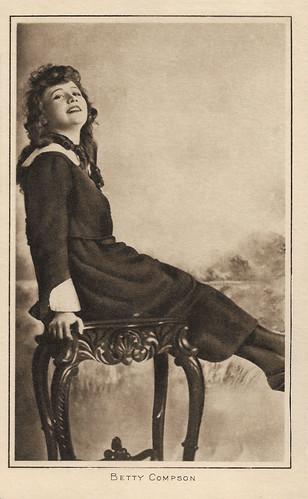
British postcard in the "Pictures" Portrait Gallery series, no. 66.
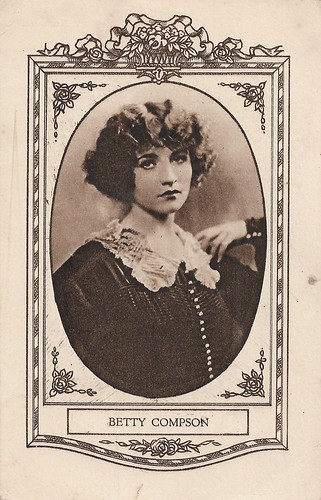
Spanish collectors card by Ed. Edoardo Pi, Barcelona.
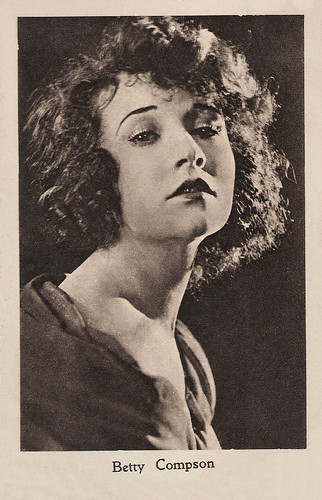
Spanish postcard for Fábrica de Chocolate de Evaristo Juncosa, Barcelona, by Huecograbado. Mumbrú, Barcelona, no. Serie A, no. 14. Collección de 14 postales Artistas Cinematograficos.
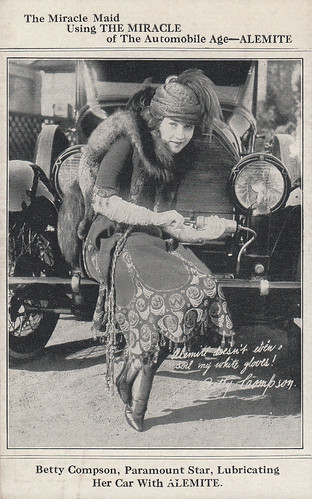
American promotion postcard for Alemite. Photo: Paramount. Collection: Marlene Pilaete.
The assistant of a demented ventriloquist
In 1928, Betty Compson appeared in a First National Pictures part-talkie, The Barker (George Fitzmaurice, 1928) opposite Milton Sills and Dorothy Mackaill. Her performance as manipulative carnival girl Carrie garnered her a nomination for the Academy Award for Best Actress. She lost to Mary Pickford in Coquette (Sam Taylor, 1929).
In the silent film Court-Martial (George B. Seitz, 1928), she became the first actress to portray Old West outlaw Belle Starr on film. The film apparently has not survived. In the same year, she received good reviews in the highly acclaimed The Docks of New York (Josef von Sternberg, 1928) in a sympathetic portrayal of a suicidal prostitute rescued by stoker George Bancroft .
She gave a touching performance in The Great Gabbo (1929), directed by her then-husband James Cruze, as the assistant of a demented ventriloquist ( Erich von Stroheim ), with whom she is unhappily in love. That same year, she appeared in RKO's first sound film, Street Girl (Wesley Ruggles, 1929). These films caused Compson's popularity to re-emerge, and she became a busy actress in the new talking cinema. In fact, Chaney offered her the female lead in his first talkie The Unholy Three (Jack Conway, 1930), but she was too busy and instead suggested friend Lila Lee.
Unlike a number of other female stars of silent film, it was felt that her voice recorded exceptionally well. Although she was not a singer, she appeared in a number of early musicals, in which her singing voice was dubbed. She divorced James Cruze in 1930. The reason for their divorce was that Cruze had an addiction to alcohol and work, which put a strain on their marriage and his health. Soon after their divorce, Cruze filed for bankruptcy, and Compson was forced to sell her Hollywood villa, her cars and her antiques to pay past years' income taxes.
However, Compson's career continued to flourish, and she starred in nine films in 1930 alone. Her last hit proved to be in The Spoilers (Edwin Carewe, 1930), alongside Gary Cooper . She was briefly under contract to RKO, and cast in so-called 'women's pictures' such as The Lady Refuses (George Archainbaud, 1931) and Three Who Loved (George Archainbaud, 1931) with Conrad Nagel .
She was unable to score a new success and only secured roles in 'poverty row' studios. One major film in which she did not appear was Gone with the Wind (Victor Fleming, 1939). Although she shot a Technicolor screen test for the role of Belle Watling, she was not cast in the role. In 1941, Compson appeared in a small role in the Hitchcock film Mr. & Mrs. Smith (Alfred Hitchcock, 1941), with Carole Lombard and Robert Montgomery.
Most of her later films were low-budget, even exploitation, efforts. Her second marriage, to producer Irving Weinberg, lasted just four years, from 1933 till 1937. At their divorce trial, she testified that he left her home alone while he went out with other women. In 1944 she married professional boxer Silvius John Gall and decided to retire from Hollywood. Compson's last film was the comedy Here Comes Trouble (Fred Guiol, 1948).
After retiring from the screen, she began a cosmetic line and helped her husband run a business named Ashtrays Unlimited, producing personalised ashtrays for the hospitality industry. Silvius Jack Gall died in 1962. All her marriages had been childless. Betty Compson died in 1974 of a heart attack at her home in Glendale, California, aged 77. She was interred in San Fernando Mission Cemetery in San Fernando, California. For her contributions to the motion picture industry, Compson has a star on the Hollywood Walk of Fame at 1751 Vine Street.
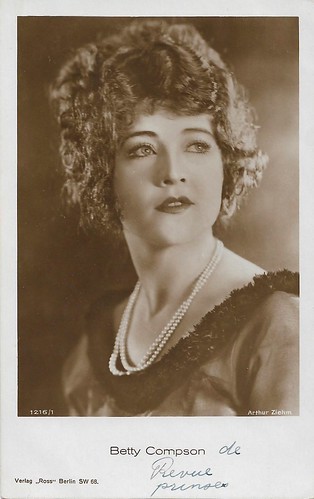
German postcard by Ross Verlag, no. 1216/1. Photo: Arthur Ziehm. Written in Dutch on the card: 'De Revueprinses', which refers to Compson's film The Belle of Broadway (Harry O. Hoyt, 1926).

Austrian postcard by Iris Verlag, no. 988. Photo: Universal Pictures Corporations. Norman Kerry and Betty Compson in Love Me and the World Is Mine (Ewald André Dupont, 1927).
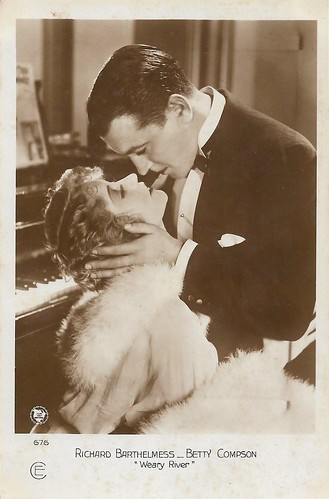
French postcard by Cinémagazine-Editions, no. 676. Photo: First National. Richard Barthelmess and Betty Compson in Weary River (Frank Lloyd, 1929).
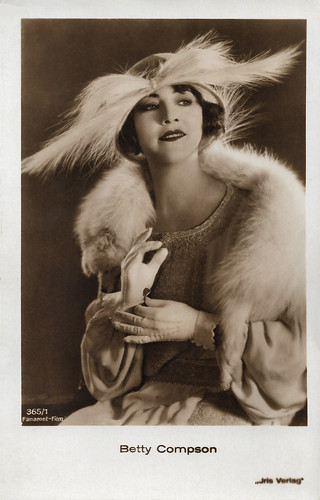
Austrian postcard by Iris-Verlag, no. 365/1. Photo: Fanamet-Film.
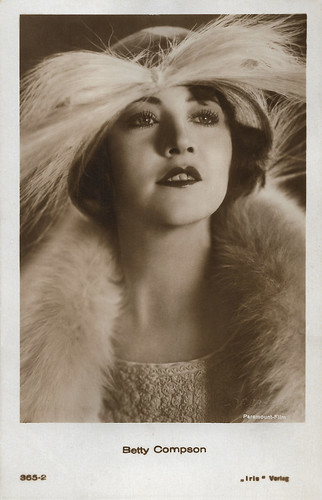
Austrian postcard by Iris Verlag, no. 365/2. Photo: Paramount-Film.
Sources: (IMDb), Wikipedia and .

French postcard by A.N., Paris in the 'Les vedettes de cinéma' series, no. 30. Photo: Film Paramount.

French postcard by Cinémagazine-Edition, no. 87.

Austrian postcard by Iris Verlag, no. 988. Photo: Universal Pictures Corporation. Betty Compson and Norman Kerry in Love Me and the World Is Mine (Ewald André Dupont, 1927).

British postcard in the Picturegoer Series, London, no. 196. Betty Compson in The Palace of Pleasure (Emmett J. Flynn, 1926) or in The Belle of Broadway (Harry O. Hoyt, 1926). Caption: Tivoli.

British postcard in the Picturegoer Series, London, no. 98. Photo: Nicholas (?).
The Prettiest Girl in Pictures
Betty Compson was born Eleanor Luicime Compson in 1897 in Beaver, Utah at a mining camp. She was the daughter of Virgil K. Compson and Mary Elizabeth Rauscher. Her father was a mining engineer, a gold prospector, and a grocery store proprietor, and her mother was a maid in homes and in a hotel. A few months after she was born, her father seemingly deserted the family for the Klondike gold strike. As it turned out, he made $25,000 - a small fortune in today's terms - and returned to the family.
Compson graduated from Salt Lake High School. Her father died when she was young and at 16 years old, she obtained employment as a violinist at a vaudeville theatre in Salt Lake City for $15 a week. Following that, she went on tour, with her mother, with an act called 'the Vagabond Violinist'.
In 1916, she appeared on the Alexander Pantages Theatre Circuit, again doing her violin solo vaudeville routine. There, the 18-year-old Compson was discovered by Hollywood producer Al Christie and she signed a contract with him. Christie quickly changed her stage name from Eleanor to Betty.
Her first silent film was the short comedy Wanted, a Leading Lady (Al Christie, 1916), starring Eddie Lyons. The following years, she appeared in many one-reel and two-reel slapstick comedies, frequently paired with Roscoe 'Fatty' Arbuckle . In 1916, she made 25 films - all of them were short comedies with the exception of one feature, Almost a Widow (Horace Davey, 1916). She continued making numerous short comedies well into the middle of 1918.
Then, after her long apprenticeship with Christie, she started making features exclusively. In 1919, Betty was signed by writer-director George Loane Tucker to co-star opposite Lon Chaney as Rose in The Miracle Man (George Loane Tucker, 1919). The film was a huge critical and financial success. Compson was called "The Prettiest Girl in Pictures". During the filming of Ladies Must Live (George Loane Tucker, 1921), Compson began a relationship with married director George Loane Tucker. However, Tucker was dying and as a favour to her, Tucker negotiated a contract with Paramount for her.
Betty Compson signed a five-year contract with the studio. Her popularity allowed Compson to establish her own production company that provided her creative control over screenplays and financing. Her first film as a producer was Prisoners of Love (Art Rosson, 1921). She played the role of Blanche Davis, a girl born to wealth and cursed by her inheritance of physical beauty. The story was chosen from a work by actress and writer Catherine Henry.
After completing The Woman With Four Faces (Herbert Brenon, 1923), with Richard Dix , Paramount refused to offer her a raise (her salary was $2,500 per week) and she refused to sign without one. Instead, she signed with Balcon, Freedman & Saville, a film company in London, England. There she starred in a series of four films directed by Graham Cutts, a well-known English filmmaker.
The first of these was a film version of an English play called Woman to Woman (Graham Cutts, 1923). The screenplay was co-written by Cutts and Alfred Hitchcock. She played a dual role in The White Shadow (Graham Cutts, 1924), also written by Alfred Hitchcock. Part of the film has been found and preserved from a collection in New Zealand.
Woman to Woman was released in the United States and proved to be popular enough for Jesse Lasky to offer top dollar to return to Paramount. Back in Hollywood, she starred in The Enemy Sex (1924), directed by James Cruze. Compson and Cruz married in 1924, but they had a rocky relationship and separated several times. One of the more highly paid performers of the silent screen, Compson's weekly earnings exceeded $5000 a week at the peak of her career. She came to own a fleet of luxury limousines and was able to move from a bungalow in the hills overlooking Hollywood to an expensive mansion on Hollywood Boulevard.
In 1925, her contract with Paramount was not renewed and she decided to freelance, working with lower budget studios such as Columbia Pictures in The Belle of Broadway (Harry O. Hoyt, 1926) and Chadwick in The Ladybird (Walter Lang, 1926), with Malcolm McGregor. During this time, she was suggested as a replacement for a difficult Greta Garbo in the MGM feature Flesh and the Devil (Clarence Brown, 1926), opposite John Gilbert. She eventually worked for the studio with former The Miracle Man co-star Lon Chaney in The Big City (Tod Browning, 1928).

British postcard in the "Pictures" Portrait Gallery series, no. 66.

Spanish collectors card by Ed. Edoardo Pi, Barcelona.

Spanish postcard for Fábrica de Chocolate de Evaristo Juncosa, Barcelona, by Huecograbado. Mumbrú, Barcelona, no. Serie A, no. 14. Collección de 14 postales Artistas Cinematograficos.

American promotion postcard for Alemite. Photo: Paramount. Collection: Marlene Pilaete.
The assistant of a demented ventriloquist
In 1928, Betty Compson appeared in a First National Pictures part-talkie, The Barker (George Fitzmaurice, 1928) opposite Milton Sills and Dorothy Mackaill. Her performance as manipulative carnival girl Carrie garnered her a nomination for the Academy Award for Best Actress. She lost to Mary Pickford in Coquette (Sam Taylor, 1929).
In the silent film Court-Martial (George B. Seitz, 1928), she became the first actress to portray Old West outlaw Belle Starr on film. The film apparently has not survived. In the same year, she received good reviews in the highly acclaimed The Docks of New York (Josef von Sternberg, 1928) in a sympathetic portrayal of a suicidal prostitute rescued by stoker George Bancroft .
She gave a touching performance in The Great Gabbo (1929), directed by her then-husband James Cruze, as the assistant of a demented ventriloquist ( Erich von Stroheim ), with whom she is unhappily in love. That same year, she appeared in RKO's first sound film, Street Girl (Wesley Ruggles, 1929). These films caused Compson's popularity to re-emerge, and she became a busy actress in the new talking cinema. In fact, Chaney offered her the female lead in his first talkie The Unholy Three (Jack Conway, 1930), but she was too busy and instead suggested friend Lila Lee.
Unlike a number of other female stars of silent film, it was felt that her voice recorded exceptionally well. Although she was not a singer, she appeared in a number of early musicals, in which her singing voice was dubbed. She divorced James Cruze in 1930. The reason for their divorce was that Cruze had an addiction to alcohol and work, which put a strain on their marriage and his health. Soon after their divorce, Cruze filed for bankruptcy, and Compson was forced to sell her Hollywood villa, her cars and her antiques to pay past years' income taxes.
However, Compson's career continued to flourish, and she starred in nine films in 1930 alone. Her last hit proved to be in The Spoilers (Edwin Carewe, 1930), alongside Gary Cooper . She was briefly under contract to RKO, and cast in so-called 'women's pictures' such as The Lady Refuses (George Archainbaud, 1931) and Three Who Loved (George Archainbaud, 1931) with Conrad Nagel .
She was unable to score a new success and only secured roles in 'poverty row' studios. One major film in which she did not appear was Gone with the Wind (Victor Fleming, 1939). Although she shot a Technicolor screen test for the role of Belle Watling, she was not cast in the role. In 1941, Compson appeared in a small role in the Hitchcock film Mr. & Mrs. Smith (Alfred Hitchcock, 1941), with Carole Lombard and Robert Montgomery.
Most of her later films were low-budget, even exploitation, efforts. Her second marriage, to producer Irving Weinberg, lasted just four years, from 1933 till 1937. At their divorce trial, she testified that he left her home alone while he went out with other women. In 1944 she married professional boxer Silvius John Gall and decided to retire from Hollywood. Compson's last film was the comedy Here Comes Trouble (Fred Guiol, 1948).
After retiring from the screen, she began a cosmetic line and helped her husband run a business named Ashtrays Unlimited, producing personalised ashtrays for the hospitality industry. Silvius Jack Gall died in 1962. All her marriages had been childless. Betty Compson died in 1974 of a heart attack at her home in Glendale, California, aged 77. She was interred in San Fernando Mission Cemetery in San Fernando, California. For her contributions to the motion picture industry, Compson has a star on the Hollywood Walk of Fame at 1751 Vine Street.

German postcard by Ross Verlag, no. 1216/1. Photo: Arthur Ziehm. Written in Dutch on the card: 'De Revueprinses', which refers to Compson's film The Belle of Broadway (Harry O. Hoyt, 1926).

Austrian postcard by Iris Verlag, no. 988. Photo: Universal Pictures Corporations. Norman Kerry and Betty Compson in Love Me and the World Is Mine (Ewald André Dupont, 1927).

French postcard by Cinémagazine-Editions, no. 676. Photo: First National. Richard Barthelmess and Betty Compson in Weary River (Frank Lloyd, 1929).

Austrian postcard by Iris-Verlag, no. 365/1. Photo: Fanamet-Film.

Austrian postcard by Iris Verlag, no. 365/2. Photo: Paramount-Film.
Sources: (IMDb), Wikipedia and .
Published on March 12, 2020 23:00
March 11, 2020
Andrex
Andrex (1907–1989) was a French film actor and singer. He was a close friend of the comedian Fernandel and appeared in many films alongside him.
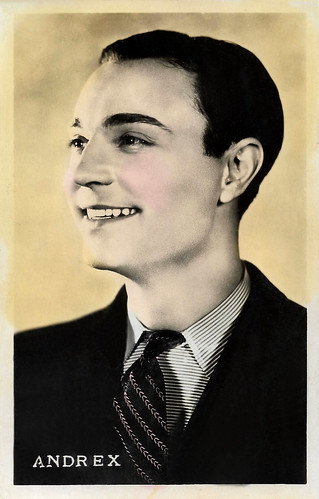
French card.
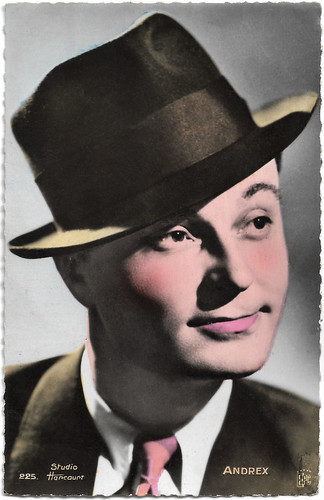
French postcard by EPC (Editions et Publications Cinématographiques), no. 225. Photo: Studio Harcourt.
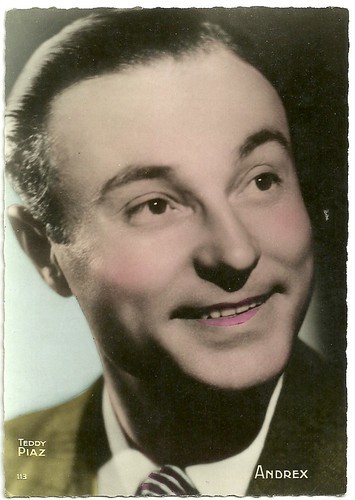
French postcard, no. 113. Photo: Teddy Piaz.
Friends for life
Andrex was born as André Jaubert in 1907 in Marseille, France. (Andrex is in English language countries also the name of a toilet roll!) At the Copello school, he met Fernandel . They became friends for life. Later, Fernandel launched him in the cinema, and helped him getting roles.
Aided by Maurice Chevalier , he made his debut as a singer at the Alcazar in Marseille, before 'going up' in Paris and performing at the Mayol Concert. He then turned to the theatre and the operetta. In 1932, he was hired by Henri Varna at the Casino de Paris, which opened the doors for him of the biggest Music Halls in the capital: the ABC, Bobino, and the Théâtre de l'Empire.
In 1931, he appeared in the short film Une idée de génie/An idea of genius (Louis Mercanton, 1931). In 1933, he played for the first time with his childhood friend Fernandel in the comedy Le Coq du régiment/The Rooster of the Regiment (Maurice Cammage, 1933). In total, they appeared in 29 films together.
When Fernandel had a contract for a new film he quite often asked if there was a part for Andrex, so he could "have a laugh and play balls" between the takes. Thus Andrex acted in Marcel Pagnol's masterpiece Angèle (Marcel Pagnol, 1934), and in other popular successes of the time: Ignace (Pierre Colombier, 1937), Barnabé (Alexandre Esway, 1938) and Les Cinq Sous de Lavarède/The Five Cents of Lavarede (Maurice Cammage, 1939).
Without Fernandel , he also played in the classic Manon (Henri-Georges Clouzot, 1949), featuring Cécile Aubry and co-starring Serge Reggiani and Michel Auclair .
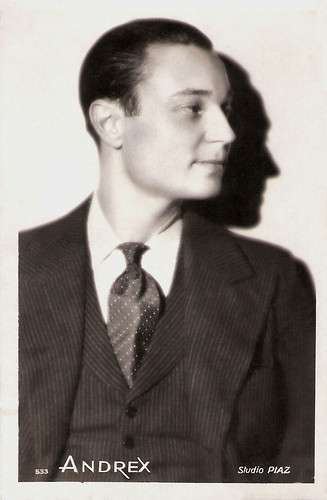
French card, no. 533. Photo: Studio Piaz.
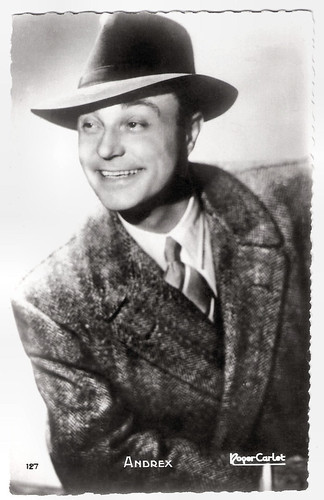
French postcard, no. 127. Photo: Roger Carlet.
A gangster more naive than clever
Andrex is best remembered for his roles in such Fernandel films as Rascasse in Simplet (Fernandel, 1942) and as the mechanic Pastèque (Watermelon) in Honoré de Marseille (Maurice Regamey, 1956).
He also appeared in the film which brought Bourvil and Fernandel together, La Cuisine au beurre (Gilles Grangier, 1963). That year, he also portrayed alongside Jean Gabin in Monsieur/Mister (Jean-Paul Le Chanois, 1963), Antoine, a gangster more naive than clever.
Apart from his acting career, Andrex continued to sing songs such as 'Comme de course', 'La Samba brésilienne' (Brazilian Samba), 'Le Régiment des Mandolines' and his greatest success 'Chez Bébert (le monte-en-l'air)'. He participated in many galas in Lyon organised by his friend Jo Darlays.
Andrex appeared in the drama L'Âge ingrat/That Tender Age (Gilles Grangier, 1964), the first film produced by Gafer, a production company founded by Jean Gabin and Fernandel .
In the early 1970s, he tried his hand at television series and appeared in the TV film Le Petit Théâtre de Jean Renoir/The Little Theatre of Jean Renoir (1970), the last completed work by Jean Renoir.
After the death, in 1971, of his wife, actress Ginette Baudin, and of Fernandel, his great friend, who helped him to have small roles in the cinema, Andrex's appearances in the media became increasingly rare. In 1973, he participated with other artists in the successful recording of French songs from the 1930s, 1940s, and 1950s.
In 1979, he appeared in the film Charles et Lucie/Charles and Lucie (Nelly Kaplan, 1979), before his final film appearance in Cap Canaille (Juliet Berto, Jean-Henri Roger, 1983).
Andrex died in 1989 in Paris, from a heart attack. He was 82. Andrex rests with his wife Ginette Baudin at the cemetery of Saint-Ouen.
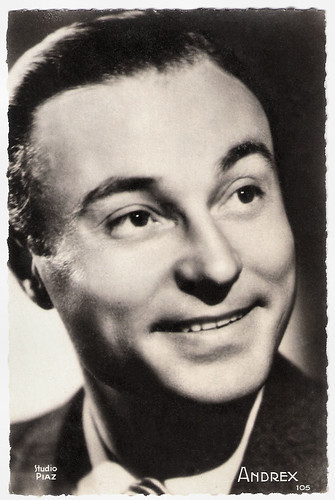
French card by Editions O.P., Paris, no. 105. Photo: Studio Piaz.
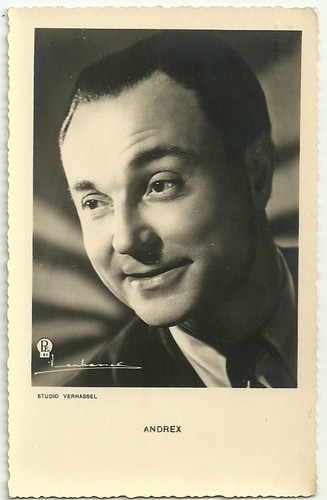
Belgian postcard by P.E., no. 68. Photo: Studio Verhassel, Brussels.
Soources: Wikipedia (French and English) and .

French card.

French postcard by EPC (Editions et Publications Cinématographiques), no. 225. Photo: Studio Harcourt.

French postcard, no. 113. Photo: Teddy Piaz.
Friends for life
Andrex was born as André Jaubert in 1907 in Marseille, France. (Andrex is in English language countries also the name of a toilet roll!) At the Copello school, he met Fernandel . They became friends for life. Later, Fernandel launched him in the cinema, and helped him getting roles.
Aided by Maurice Chevalier , he made his debut as a singer at the Alcazar in Marseille, before 'going up' in Paris and performing at the Mayol Concert. He then turned to the theatre and the operetta. In 1932, he was hired by Henri Varna at the Casino de Paris, which opened the doors for him of the biggest Music Halls in the capital: the ABC, Bobino, and the Théâtre de l'Empire.
In 1931, he appeared in the short film Une idée de génie/An idea of genius (Louis Mercanton, 1931). In 1933, he played for the first time with his childhood friend Fernandel in the comedy Le Coq du régiment/The Rooster of the Regiment (Maurice Cammage, 1933). In total, they appeared in 29 films together.
When Fernandel had a contract for a new film he quite often asked if there was a part for Andrex, so he could "have a laugh and play balls" between the takes. Thus Andrex acted in Marcel Pagnol's masterpiece Angèle (Marcel Pagnol, 1934), and in other popular successes of the time: Ignace (Pierre Colombier, 1937), Barnabé (Alexandre Esway, 1938) and Les Cinq Sous de Lavarède/The Five Cents of Lavarede (Maurice Cammage, 1939).
Without Fernandel , he also played in the classic Manon (Henri-Georges Clouzot, 1949), featuring Cécile Aubry and co-starring Serge Reggiani and Michel Auclair .

French card, no. 533. Photo: Studio Piaz.

French postcard, no. 127. Photo: Roger Carlet.
A gangster more naive than clever
Andrex is best remembered for his roles in such Fernandel films as Rascasse in Simplet (Fernandel, 1942) and as the mechanic Pastèque (Watermelon) in Honoré de Marseille (Maurice Regamey, 1956).
He also appeared in the film which brought Bourvil and Fernandel together, La Cuisine au beurre (Gilles Grangier, 1963). That year, he also portrayed alongside Jean Gabin in Monsieur/Mister (Jean-Paul Le Chanois, 1963), Antoine, a gangster more naive than clever.
Apart from his acting career, Andrex continued to sing songs such as 'Comme de course', 'La Samba brésilienne' (Brazilian Samba), 'Le Régiment des Mandolines' and his greatest success 'Chez Bébert (le monte-en-l'air)'. He participated in many galas in Lyon organised by his friend Jo Darlays.
Andrex appeared in the drama L'Âge ingrat/That Tender Age (Gilles Grangier, 1964), the first film produced by Gafer, a production company founded by Jean Gabin and Fernandel .
In the early 1970s, he tried his hand at television series and appeared in the TV film Le Petit Théâtre de Jean Renoir/The Little Theatre of Jean Renoir (1970), the last completed work by Jean Renoir.
After the death, in 1971, of his wife, actress Ginette Baudin, and of Fernandel, his great friend, who helped him to have small roles in the cinema, Andrex's appearances in the media became increasingly rare. In 1973, he participated with other artists in the successful recording of French songs from the 1930s, 1940s, and 1950s.
In 1979, he appeared in the film Charles et Lucie/Charles and Lucie (Nelly Kaplan, 1979), before his final film appearance in Cap Canaille (Juliet Berto, Jean-Henri Roger, 1983).
Andrex died in 1989 in Paris, from a heart attack. He was 82. Andrex rests with his wife Ginette Baudin at the cemetery of Saint-Ouen.

French card by Editions O.P., Paris, no. 105. Photo: Studio Piaz.

Belgian postcard by P.E., no. 68. Photo: Studio Verhassel, Brussels.
Soources: Wikipedia (French and English) and .
Published on March 11, 2020 23:00
March 10, 2020
Marthe Régnier
Marthe Régnier (1880-1967) was a beautiful and famous French stage actress and singer of the Belle Epoque and beyond. She launched her own perfume, designed fashion and jewelry, and was the companion of Baron Rothschild. Regnier also acted in six silent and sound films.
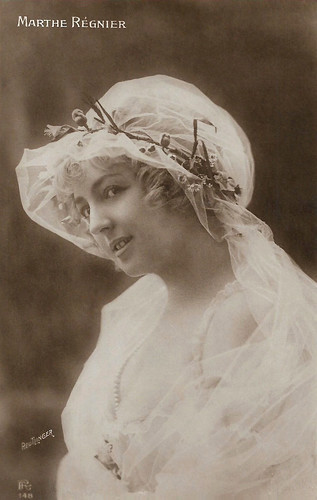
French postcard by FA, no. 148. Photo: Reutlinger.

French postcard by PC, no. 4095. Photo: Reutlinger, Paris.
The mistress of Baron Henri de Rothschild
Marthe Régnier was born in 1880 in Paris.
In 1901 she entered the Comédie-Française and made her debut in a play called 'Agnès'. After alternating drama (e.g. Hugo) with comedy (e.g Beaumarchais) at the Comédie, she moved in 1903 to vaudeville, where she acted for years at the Théâtre du Vaudeville in plays by e.g. Bernard and Mirbeau. Among her favourite authors were Robert de Flers ('l'Ane de Buridan', and 'le Retour'), Stève Passeur ('Etienne'), and Paul Gavault (la Petite Chocolatière).
In 1934 she acted as Jocaste opposite Jean-Pierre Aumont as Oedipus in Jean Cocteau's 'La Machine infernale' (1934), which premiered at the Comédie des Champs-Élysées in Paris, then the theatre of Louis Jouvet . This role more or less signed the end of her stage career.
In 1902. she married playwright Abel Tarride Régnier was the mother of director Jean Tarride and actor Jacques Tarride. She divorced Tarride and married in 1916 José de Oliveira Murinelly, secretary of the Brazilian embassy in France.
From ca. 1920 she was the mistress of Baron Henri de Rothschild, who, aside of being a millionaire, doctor, and founder in 1902 of the first modern children hospital in France, had developed as a playwright under the name of André Pascal. He wrote 'La Caducée', the controversial play on medical malpractice. He was the theatre manager too, taking over the Théàtre Antoine in the early 1920s.
In four years, De Rothschild had the new, ultramodern Pigalle Theatre built, which opened in 1929 and was the 'baby' of his son Philippe, but the theatre didn't fare too well. Philippe fared better afterward with wine: the famous Mouton-Rothschild. After the early death of Henri de Rothschild's wife in 1926, Régnier became his companion, who would follow him in exile during the war.
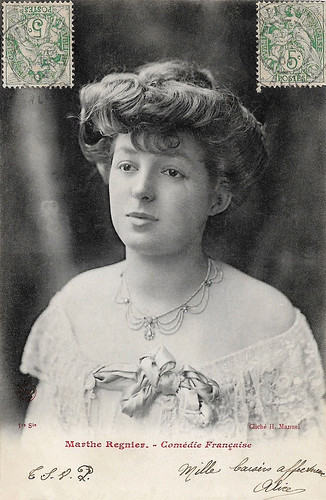
French postcard, 1e Serie. Photo: H. [Henri] Manuel. Caption: Marthe Régnier of the Comédie Française.
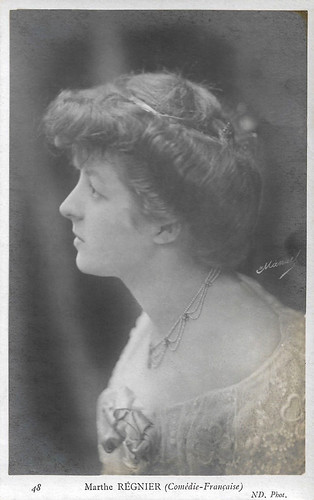
French postcard by ND Phot., no. 48. Photo: Manuel. Caption: Marthe Régnier (Comédie française).
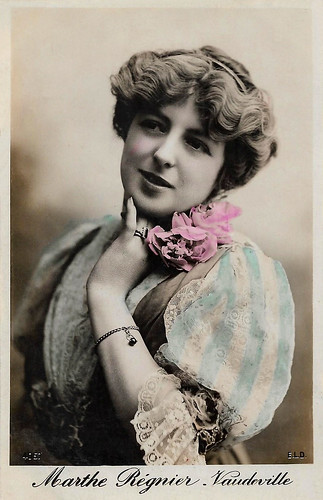
French postcard. by E.L.D., no. 4157. Caption: Marthe Régnier, Vaudeville.
A businesswoman ahead of her time
Marthe Régnier was highly interested in fashion and jewelry, and as a businesswoman, she was ahead of her time. She was often photographed to publicise her own creations. In the 1910s she launched her own perfume, entitled 'Suivez-moi, jeune homme' (Follow me, young man). Régnier was portrayed by famous painters like Giovanni Boldini, who painted a magnificent, dynamic portrait of her in 1905, and photographers such as Reutlinger, Henri Manuel and Adolph Meyer.
In 1910, Régnier debuted in the title role of the short film Manon, produced by Pathé Frères and based on the famous novel (1731) by Abbé Prevost and on the opera (1884) by Jules Massenet. Her co-actors were also popular stage actors: Jean Périer played Lescaut, while Émile Dehelly played Des Grieux.
In 1918 Régnier acted opposite Musidora in Germaine Dulac's film La jeune fille la plus méritante de France (1918).
When sound film set in, Régnier returned to the sets to act as the maid in the comedy Y'en a pas deux comme Angélique (Roger Lion, 1931), starring Colette Darfeuil .
Next, she was the wife of Jacques Baumer in Étienne (1933), directed by her son Jean Tarride, and with Jean Forest in the title role. It was based on a play by Jacques Deval, in which she had acted in 1929. Opposite Charles Boyer as Crown Prince Rudolph of Austria, Régnier was Danielle Darrieux 's mother, Baroness Vetsera, in the romantic historical drama Mayerling (Anatole Litvak, 1936).
Régnier's last film was Les hommes sans peur (Yvan Noë, 1942), about the inventors of X-Rays, in which she played a sick woman. Perhaps her shots were taken before the German invasion, because Rothschild's biographer Harry W. Paul and others too write that she remained with Rothschild in Lisbon, Portugal, during the war years.
Anyway, she stayed close to him till the end. Rothschild, a heavy smoker, and diabetic, died near Lausanne, Switzerland, in 1947, at the age of 75. Marthe Régnier died in Paris in 1967, at the age of 86. She rests in the cemetery of Marly-le-Roi (Yvelines).
In 2011 Boldini’s 'Portrait of Marthe Régnier' was sold to a private European buyer for $1,874,500. In 2012 part of her jewelry was sold in Fontainebleau.
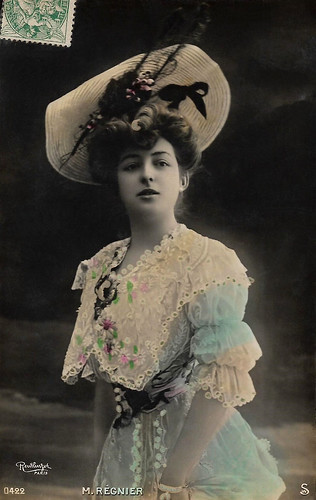
French postcard by SW, no. 0422. Photo: Reutlinger, Paris.
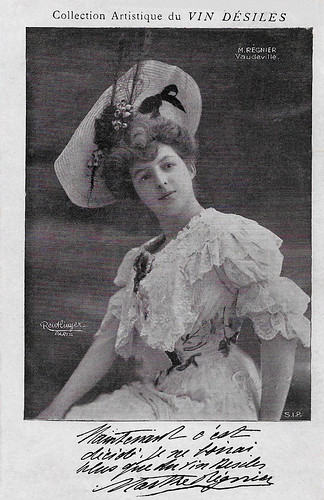
French postcard by S.I.P. in the Collection Artistique du Vin Désiles. Photo: Reutlinger, Paris. Caption: It's decided now, I won't drink but Vin Désiles.
Sources: Wikimedia Commons, Wikipedia (French), and : and also biographies of Henry de Rothschild by Harry W. Paul and Nadège Forestier,

French postcard by FA, no. 148. Photo: Reutlinger.

French postcard by PC, no. 4095. Photo: Reutlinger, Paris.
The mistress of Baron Henri de Rothschild
Marthe Régnier was born in 1880 in Paris.
In 1901 she entered the Comédie-Française and made her debut in a play called 'Agnès'. After alternating drama (e.g. Hugo) with comedy (e.g Beaumarchais) at the Comédie, she moved in 1903 to vaudeville, where she acted for years at the Théâtre du Vaudeville in plays by e.g. Bernard and Mirbeau. Among her favourite authors were Robert de Flers ('l'Ane de Buridan', and 'le Retour'), Stève Passeur ('Etienne'), and Paul Gavault (la Petite Chocolatière).
In 1934 she acted as Jocaste opposite Jean-Pierre Aumont as Oedipus in Jean Cocteau's 'La Machine infernale' (1934), which premiered at the Comédie des Champs-Élysées in Paris, then the theatre of Louis Jouvet . This role more or less signed the end of her stage career.
In 1902. she married playwright Abel Tarride Régnier was the mother of director Jean Tarride and actor Jacques Tarride. She divorced Tarride and married in 1916 José de Oliveira Murinelly, secretary of the Brazilian embassy in France.
From ca. 1920 she was the mistress of Baron Henri de Rothschild, who, aside of being a millionaire, doctor, and founder in 1902 of the first modern children hospital in France, had developed as a playwright under the name of André Pascal. He wrote 'La Caducée', the controversial play on medical malpractice. He was the theatre manager too, taking over the Théàtre Antoine in the early 1920s.
In four years, De Rothschild had the new, ultramodern Pigalle Theatre built, which opened in 1929 and was the 'baby' of his son Philippe, but the theatre didn't fare too well. Philippe fared better afterward with wine: the famous Mouton-Rothschild. After the early death of Henri de Rothschild's wife in 1926, Régnier became his companion, who would follow him in exile during the war.

French postcard, 1e Serie. Photo: H. [Henri] Manuel. Caption: Marthe Régnier of the Comédie Française.

French postcard by ND Phot., no. 48. Photo: Manuel. Caption: Marthe Régnier (Comédie française).

French postcard. by E.L.D., no. 4157. Caption: Marthe Régnier, Vaudeville.
A businesswoman ahead of her time
Marthe Régnier was highly interested in fashion and jewelry, and as a businesswoman, she was ahead of her time. She was often photographed to publicise her own creations. In the 1910s she launched her own perfume, entitled 'Suivez-moi, jeune homme' (Follow me, young man). Régnier was portrayed by famous painters like Giovanni Boldini, who painted a magnificent, dynamic portrait of her in 1905, and photographers such as Reutlinger, Henri Manuel and Adolph Meyer.
In 1910, Régnier debuted in the title role of the short film Manon, produced by Pathé Frères and based on the famous novel (1731) by Abbé Prevost and on the opera (1884) by Jules Massenet. Her co-actors were also popular stage actors: Jean Périer played Lescaut, while Émile Dehelly played Des Grieux.
In 1918 Régnier acted opposite Musidora in Germaine Dulac's film La jeune fille la plus méritante de France (1918).
When sound film set in, Régnier returned to the sets to act as the maid in the comedy Y'en a pas deux comme Angélique (Roger Lion, 1931), starring Colette Darfeuil .
Next, she was the wife of Jacques Baumer in Étienne (1933), directed by her son Jean Tarride, and with Jean Forest in the title role. It was based on a play by Jacques Deval, in which she had acted in 1929. Opposite Charles Boyer as Crown Prince Rudolph of Austria, Régnier was Danielle Darrieux 's mother, Baroness Vetsera, in the romantic historical drama Mayerling (Anatole Litvak, 1936).
Régnier's last film was Les hommes sans peur (Yvan Noë, 1942), about the inventors of X-Rays, in which she played a sick woman. Perhaps her shots were taken before the German invasion, because Rothschild's biographer Harry W. Paul and others too write that she remained with Rothschild in Lisbon, Portugal, during the war years.
Anyway, she stayed close to him till the end. Rothschild, a heavy smoker, and diabetic, died near Lausanne, Switzerland, in 1947, at the age of 75. Marthe Régnier died in Paris in 1967, at the age of 86. She rests in the cemetery of Marly-le-Roi (Yvelines).
In 2011 Boldini’s 'Portrait of Marthe Régnier' was sold to a private European buyer for $1,874,500. In 2012 part of her jewelry was sold in Fontainebleau.

French postcard by SW, no. 0422. Photo: Reutlinger, Paris.

French postcard by S.I.P. in the Collection Artistique du Vin Désiles. Photo: Reutlinger, Paris. Caption: It's decided now, I won't drink but Vin Désiles.
Sources: Wikimedia Commons, Wikipedia (French), and : and also biographies of Henry de Rothschild by Harry W. Paul and Nadège Forestier,
Published on March 10, 2020 23:00
March 9, 2020
Le mot de l'énigme (1916)
Today, EFSP has another film special with Spanish Chocolate cards from the collection of Ivo Blom. The subject is the French film Le mot de l'énigme/The Word of The Enigma (Georges Monca, 1916), a Pathé Frères production with Gabrielle Robinne, Jean Kemm, Henri Bosc and Andrée Pascal. Chocolate Salas-Sabadell made a series of six cards for the film, which was titled Celos mortales (Mortal skies) for Spain. Ivo has acquired five of them.
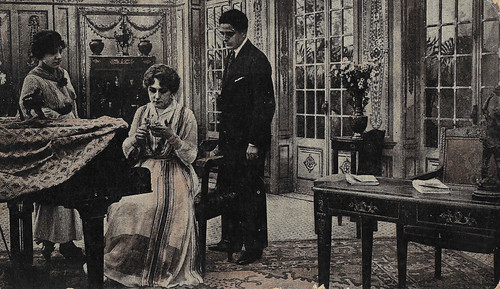
Spanish collectors card by Chocolate Salas-Sabadell, no. 1. Photo: Pathé Frères. Gabrielle Robinne , Henri Bosc and Andrée Pascal in Le mot de l'énigme (Georges Monca, 1916).
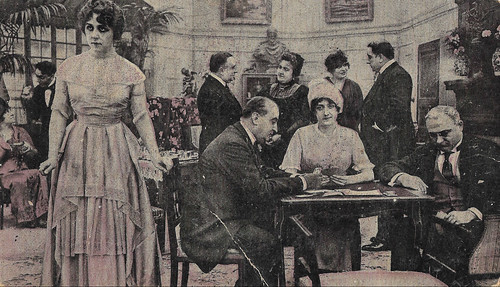
Spanish collectors card by Chocolate Salas-Sabadell, no. 2. Photo: Pathé Frères. Gabrielle Robinne (left) and Jean Kemm (at the table) in Le mot de l'énigme (Georges Monca, 1916).
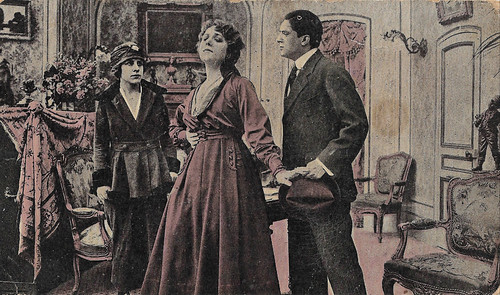
Spanish collectors card by Chocolate Salas-Sabadell, no. 3. Photo: Pathé Frères. Gabrielle Robinne , Henri Bosc and Andrée Pascal in Le mot de l'énigme (Georges Monca, 1916).
The forbidden marriage
Jean Kemm plays in Le mot de l'énigme/The Word of The Enigma (Georges Monca, 1916) the elder Robert Duroc, who falls in love with young Lucy Le Quesnel ( Gabrielle Robinne ), in vain. In the countryside, Lucy visits her friend Thérèse Tillier (Andrée Pascal) and falls in love with her brother Maxime (Henri Bosc).
Yet, Mr. Tillier forbids marriage between Lucy and Maxime when he hears about the financial misfortune of Lucy's family and sends his son to the US. The father even removes a letter by Maxime asking Lucy in marriage. Lucy thinks Maxime has abandoned her and marries Duroc, who generously offers his fortune to save Lucy's family.
Years pass by. Lucy hasn't forgotten Maxime but her heart now belongs to her husband. Maxim reappears but Lucy avoids him, withdrawing to the countryside. Maxime has followed her.
The husband thinks he has seen him leaving the villa, so he bluntly confronts Lucy by telling him that Maxim's car crashed: he has killed himself. Lucy's face decomposes and she mortally collapses. All the help comes too late.
It is not clear who played father Tillier in Le mot de l'énigme, but Lucy's parents were played by Léon Bernard and Paule Andral.
The film came out at the Paris cinema Omnia Pathé, on 3 August 1916. It was produced by Société cinématographique des auteurs et gens de lettres (SCAGL) for Pathé Frères. It was a typical example of the many films Robinne did with director Georges Monca between 1915 and 1917. In the years 1912-1915, she had made films with René Leprince with her fixed partner and husband René Alexandre .
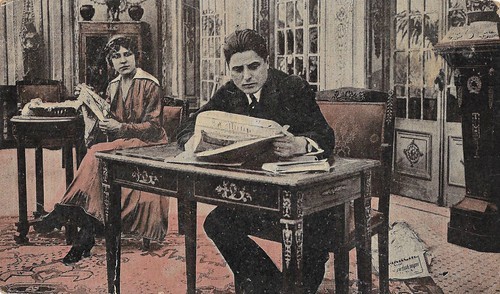
Spanish collectors card by Chocolate Salas-Sabadell, no. 4. Photo: Pathé Frères. Henri Bosc and Andrée Pascal in Le mot de l'énigme (Georges Monca, 1916).
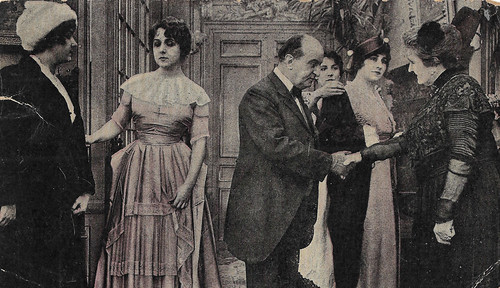
Spanish collectors card by Chocolate Salas-Sabadell, no. 6. Photo: Pathé Frères. Gabrielle Robinne and Jean Kemm in Le mot de l'énigme (Georges Monca, 1916).
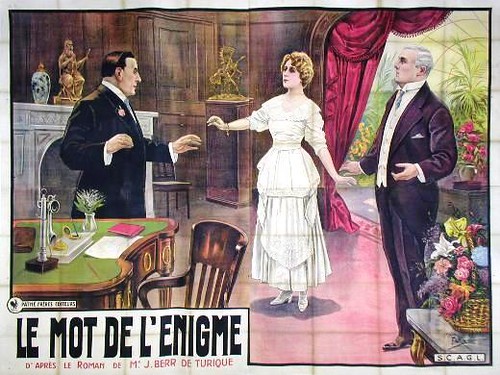
The French poster for Le mot de l'énigme (Georges Monca, 1916). Source: Larry Smith @ Flickr.
Sources: Fondation Jerome Seydoux Pathe (French) and IMDb.

Spanish collectors card by Chocolate Salas-Sabadell, no. 1. Photo: Pathé Frères. Gabrielle Robinne , Henri Bosc and Andrée Pascal in Le mot de l'énigme (Georges Monca, 1916).

Spanish collectors card by Chocolate Salas-Sabadell, no. 2. Photo: Pathé Frères. Gabrielle Robinne (left) and Jean Kemm (at the table) in Le mot de l'énigme (Georges Monca, 1916).

Spanish collectors card by Chocolate Salas-Sabadell, no. 3. Photo: Pathé Frères. Gabrielle Robinne , Henri Bosc and Andrée Pascal in Le mot de l'énigme (Georges Monca, 1916).
The forbidden marriage
Jean Kemm plays in Le mot de l'énigme/The Word of The Enigma (Georges Monca, 1916) the elder Robert Duroc, who falls in love with young Lucy Le Quesnel ( Gabrielle Robinne ), in vain. In the countryside, Lucy visits her friend Thérèse Tillier (Andrée Pascal) and falls in love with her brother Maxime (Henri Bosc).
Yet, Mr. Tillier forbids marriage between Lucy and Maxime when he hears about the financial misfortune of Lucy's family and sends his son to the US. The father even removes a letter by Maxime asking Lucy in marriage. Lucy thinks Maxime has abandoned her and marries Duroc, who generously offers his fortune to save Lucy's family.
Years pass by. Lucy hasn't forgotten Maxime but her heart now belongs to her husband. Maxim reappears but Lucy avoids him, withdrawing to the countryside. Maxime has followed her.
The husband thinks he has seen him leaving the villa, so he bluntly confronts Lucy by telling him that Maxim's car crashed: he has killed himself. Lucy's face decomposes and she mortally collapses. All the help comes too late.
It is not clear who played father Tillier in Le mot de l'énigme, but Lucy's parents were played by Léon Bernard and Paule Andral.
The film came out at the Paris cinema Omnia Pathé, on 3 August 1916. It was produced by Société cinématographique des auteurs et gens de lettres (SCAGL) for Pathé Frères. It was a typical example of the many films Robinne did with director Georges Monca between 1915 and 1917. In the years 1912-1915, she had made films with René Leprince with her fixed partner and husband René Alexandre .

Spanish collectors card by Chocolate Salas-Sabadell, no. 4. Photo: Pathé Frères. Henri Bosc and Andrée Pascal in Le mot de l'énigme (Georges Monca, 1916).

Spanish collectors card by Chocolate Salas-Sabadell, no. 6. Photo: Pathé Frères. Gabrielle Robinne and Jean Kemm in Le mot de l'énigme (Georges Monca, 1916).

The French poster for Le mot de l'énigme (Georges Monca, 1916). Source: Larry Smith @ Flickr.
Sources: Fondation Jerome Seydoux Pathe (French) and IMDb.
Published on March 09, 2020 23:00
March 8, 2020
Alice Cocéa
Alice Cocéa (1899-1970) was a Romanian-born French stage and screen actress, who peaked in early 1930s French cinema. The suicide of her lover caused her to retire for a while. She was the director of a Parisian theatre during the occupation. After the war, she was arrested on charges of collaboration and was imprisoned for some time.
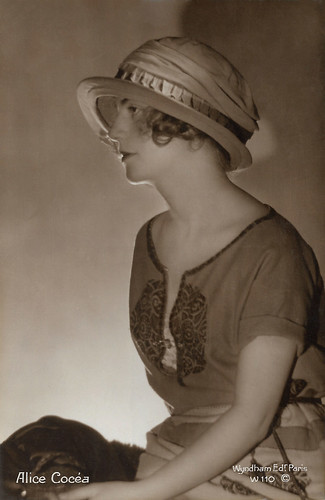
French postcard by Wyndham Ed., Paris, no. W110.
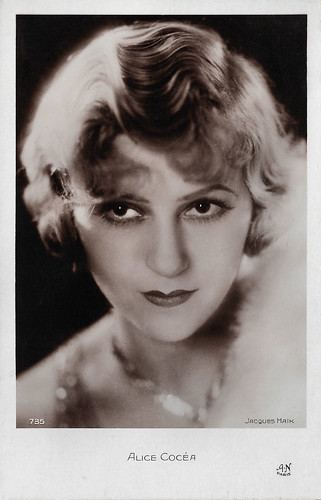
French postcard by A.N., Paris, no. 735. Photo: Jacques Haïk.
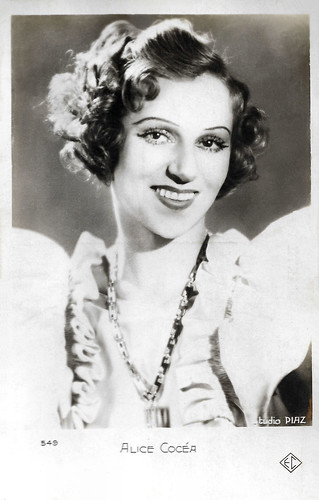
French postcard by E.C., Paris, no. 549. Photo: Studio Piaz.
Star position in the Parisian theatre scene
Alice Cocéa, originally Sophie Alice Cocéa, was born in 1899 in Sinaia (Romania) as the daughter of General Dimitrie Cocea and his wife Cleopatra. Alice had one sister, Florica (later married Bressy) and one brother, Nicolae, the later socialist journalist and novelist N. D. Cocea. The Cocea family was of Albanian origin. Alice was the aunt of actress Dina Cocea.
Cocéa initially attended courses at the Conservatory in Bucharest but then studied drama in Paris. She graduated in 1917 and settled in France. She made her film debut in the film Le Delai (Jacques de Baroncelli, 1918). But she preferred to pursue a - successful - theatrical and operetta career. She appeared in two operettas by Henri Christiné and Albert Willemetz, 'Phi-Phi' (1918) and Dédé (1921), the latter with Maurice Chevalier .
In the 1920s, she performed e.g. at the Comédie Caumartin, Théâtre Daunou, Théâtre Michel, and the Comédie des Champs-Élysées. Some of her songs were recorded on records. From her star position in the Parisian theatre scene, Alice Cocéa returned to the big screen in 1930 and had a fruitful film career in the early 1930s. Her first sound film was Mon gosse de père/My Kid of a Father (Jean de Limur, 1930), starring Adolphe Menjou , while she had the female lead as his young wife. The film was the alternate French version of The Parisian (1931), in which Elissa Landi played Cocéa's part. Both versions were filmed at the Pathé-Natan studio in Paris.
At the Paris Paramount studios, Cocéa was paired with a young Fernand Gravey in Marions-nous/Let's Get Married (Louis Mercanton, 1931); with Jean Angelo and Florelle in Atout coeur/Heart trump (Henry Roussel, 1931), in which she had a popular song, 'Si j'aimais'; and with Henri Garat in Delphine (Roger Capellani, 1931).
Next, at the Studio Jacques Haïk, she starred opposite André Roanne in Nicole et sa vertu/Nicole and Her Virtue (René Hervil, 1932). She played a wife who acts as a mundane woman just to get her husband back. In 1934 she acted with Harry Baur in Le greluchon délicat/A Sensitive Lad (Jean Choux, 1934), in which she supports a penniless student, played by Paul Bernard. The previous year, Baur had directed her on stage in 'La Voie lactée' by Alfred Savoir, at the Théâtre des Mathurins.
In 1926, Cocéa married Count Stanislas de Rochefoucauld, but the marriage ended in divorce in 1931. Her affair with Lieutenant Victor Point, Marcellin Berthelot's great-grandfather, ended in 1932 by his suicide after Alice's refusal to marry him after her divorce. They had been involved for three years, and she had promised to become his wife once her divorce from Rochefoucauld had been settled. Cocéa announced her retirement shortly after Point's death, stating that she would join a convent.
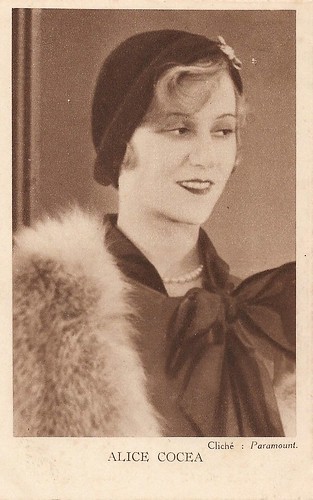
Belgian postcard by S.A. Cacao et Chocolat Kivou, Vilvoorde / N.V. Cacao en Chocolade Kivou, Vilvoorde.
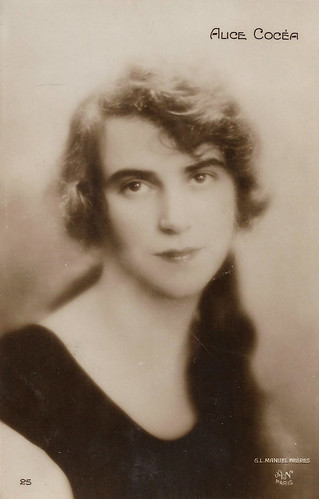
French postcard by A.N., Paris, no. 25. Photo: G.L. Manuel Frères.
Forbidden for its immorality
In the later 1930s, Alice Cocéa only did theatre. From 1937 she both acted and directed at the Théâtre des Ambassadeurs, run on behalf of the City of Paris by her husband Roger Capgras (1900-1963), a former fruit vendor of Les Halles, who thanks to his business in fruit juices had become an important Maecenas of the press and the theatre. Capgras was an editor at the Germanophile Paris-Soir, and founded in 1940 an independent newspaper, Aujourd'hui, which during the Occupation became a source of propaganda for the Nazis.
During the Occupation, Capgras himself, who first had tried to make friends with the occupiers, was interned. In 1941, he fled to North Africa and was interned there too, but also helped British 'Toppy' Black to open a series of clubs for British soldiers in Algiers and Tunis. After the war, he would be a mediator between his friend prime minister Edgar Faure, the French army, and the local Moroccan authorities.
On 14 November 1938, Alice Cocéa directed and acted on the first night of 'Les Parents terribles' by Jean Cocteau at the Théâtre des Ambassadeurs. In the play, Georges (Marcel André) played a gentle and dreamy father, who is entirely dominated by the whims of his wife, Yvonne ( Germaine Dermoz ), a diabetic who suffers from frequent illnesses. With Michel ( Jean Marais ), their adored son, the parents live on the hook of Léonie (Gabrielle Dorziat), who was once the fiancee of Georges who preferred his sister to him. These four people live together until the day when Madeleine (Cocéa), Georges' mistress and the son's new lover arises.
According to French Wikipedia , Roger Capgras came to rescue with his theatre when Cocteau could not find a theatre to stage his new play. Cocéa, then Capgras' mistress, would play Madeleine instead of Madeleine Ozeray , Cocteau's initial choice. Yvonne, a role intended for Yvonne de Bray , was played by Dermoz. The play was a huge critical success, if not by the far-right, and neither by the City of Paris when Capgras wanted to invite Parisian high school pupils to the play. The play became forbidden for its immorality and closed down on 20 December 1938.
The radical press came to Cocteau's rescue and the play was retaken at the Théâtre des Bouffes Parisiens, where it was on show between January and June 1939. From 1940 to 1944, Cocéa was director of the Théâtre des Ambassadeurs, where she alternated stage directions of serious work by Molière and Ibsen with lighter work by Feydeau and others.
At the war's end, she was arrested on charges of collaboration and was imprisoned for some time. However, from 1947 she returned some 15 times to the stage as an actress and also five times as a director too. Her memoirs, 'Mes amours que j'ai tant aimées' (The Loves I So Loved), were published in 1958. During the 1960s, she had two bit-part appearances in the cinema. Her last screen appearance was as a concierge in Roger Vadim's La Ronde/Circle of Love (1964), starring Jane Fonda . After her retirement she dedicated herself to her passion for painting.
Alice Cocéa died in 1970, after a short illness. She was 70. Cocéa was buried at the cemetery of Saint-Brisson-sur-Loire. Her cousin Armand de La Rochefoucauld recently rehabilitated her grave.
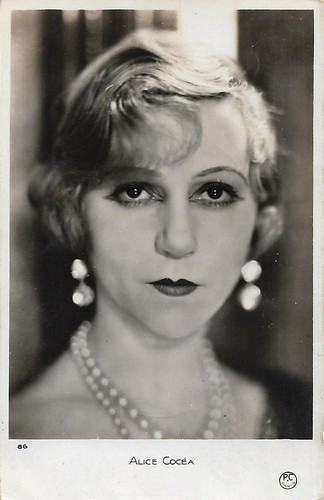
French postcard by P.C., Paris, no. 86.
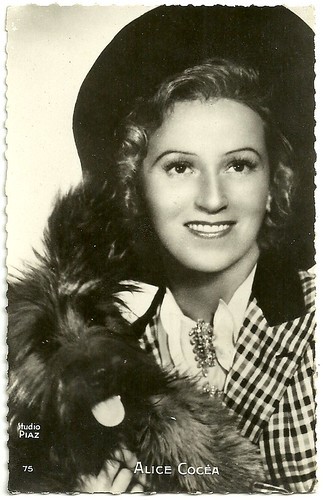
French postcard, no. 75. Photo: Studio Paz.
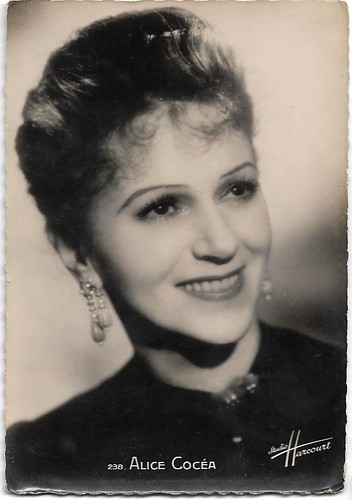
French postcard, no. 238. Photo: Studio Harcourt.
Sources: Caroline Hanotte (CinéArtistes - French), Wikipedia (French, English and Romanian), and .

French postcard by Wyndham Ed., Paris, no. W110.

French postcard by A.N., Paris, no. 735. Photo: Jacques Haïk.

French postcard by E.C., Paris, no. 549. Photo: Studio Piaz.
Star position in the Parisian theatre scene
Alice Cocéa, originally Sophie Alice Cocéa, was born in 1899 in Sinaia (Romania) as the daughter of General Dimitrie Cocea and his wife Cleopatra. Alice had one sister, Florica (later married Bressy) and one brother, Nicolae, the later socialist journalist and novelist N. D. Cocea. The Cocea family was of Albanian origin. Alice was the aunt of actress Dina Cocea.
Cocéa initially attended courses at the Conservatory in Bucharest but then studied drama in Paris. She graduated in 1917 and settled in France. She made her film debut in the film Le Delai (Jacques de Baroncelli, 1918). But she preferred to pursue a - successful - theatrical and operetta career. She appeared in two operettas by Henri Christiné and Albert Willemetz, 'Phi-Phi' (1918) and Dédé (1921), the latter with Maurice Chevalier .
In the 1920s, she performed e.g. at the Comédie Caumartin, Théâtre Daunou, Théâtre Michel, and the Comédie des Champs-Élysées. Some of her songs were recorded on records. From her star position in the Parisian theatre scene, Alice Cocéa returned to the big screen in 1930 and had a fruitful film career in the early 1930s. Her first sound film was Mon gosse de père/My Kid of a Father (Jean de Limur, 1930), starring Adolphe Menjou , while she had the female lead as his young wife. The film was the alternate French version of The Parisian (1931), in which Elissa Landi played Cocéa's part. Both versions were filmed at the Pathé-Natan studio in Paris.
At the Paris Paramount studios, Cocéa was paired with a young Fernand Gravey in Marions-nous/Let's Get Married (Louis Mercanton, 1931); with Jean Angelo and Florelle in Atout coeur/Heart trump (Henry Roussel, 1931), in which she had a popular song, 'Si j'aimais'; and with Henri Garat in Delphine (Roger Capellani, 1931).
Next, at the Studio Jacques Haïk, she starred opposite André Roanne in Nicole et sa vertu/Nicole and Her Virtue (René Hervil, 1932). She played a wife who acts as a mundane woman just to get her husband back. In 1934 she acted with Harry Baur in Le greluchon délicat/A Sensitive Lad (Jean Choux, 1934), in which she supports a penniless student, played by Paul Bernard. The previous year, Baur had directed her on stage in 'La Voie lactée' by Alfred Savoir, at the Théâtre des Mathurins.
In 1926, Cocéa married Count Stanislas de Rochefoucauld, but the marriage ended in divorce in 1931. Her affair with Lieutenant Victor Point, Marcellin Berthelot's great-grandfather, ended in 1932 by his suicide after Alice's refusal to marry him after her divorce. They had been involved for three years, and she had promised to become his wife once her divorce from Rochefoucauld had been settled. Cocéa announced her retirement shortly after Point's death, stating that she would join a convent.

Belgian postcard by S.A. Cacao et Chocolat Kivou, Vilvoorde / N.V. Cacao en Chocolade Kivou, Vilvoorde.

French postcard by A.N., Paris, no. 25. Photo: G.L. Manuel Frères.
Forbidden for its immorality
In the later 1930s, Alice Cocéa only did theatre. From 1937 she both acted and directed at the Théâtre des Ambassadeurs, run on behalf of the City of Paris by her husband Roger Capgras (1900-1963), a former fruit vendor of Les Halles, who thanks to his business in fruit juices had become an important Maecenas of the press and the theatre. Capgras was an editor at the Germanophile Paris-Soir, and founded in 1940 an independent newspaper, Aujourd'hui, which during the Occupation became a source of propaganda for the Nazis.
During the Occupation, Capgras himself, who first had tried to make friends with the occupiers, was interned. In 1941, he fled to North Africa and was interned there too, but also helped British 'Toppy' Black to open a series of clubs for British soldiers in Algiers and Tunis. After the war, he would be a mediator between his friend prime minister Edgar Faure, the French army, and the local Moroccan authorities.
On 14 November 1938, Alice Cocéa directed and acted on the first night of 'Les Parents terribles' by Jean Cocteau at the Théâtre des Ambassadeurs. In the play, Georges (Marcel André) played a gentle and dreamy father, who is entirely dominated by the whims of his wife, Yvonne ( Germaine Dermoz ), a diabetic who suffers from frequent illnesses. With Michel ( Jean Marais ), their adored son, the parents live on the hook of Léonie (Gabrielle Dorziat), who was once the fiancee of Georges who preferred his sister to him. These four people live together until the day when Madeleine (Cocéa), Georges' mistress and the son's new lover arises.
According to French Wikipedia , Roger Capgras came to rescue with his theatre when Cocteau could not find a theatre to stage his new play. Cocéa, then Capgras' mistress, would play Madeleine instead of Madeleine Ozeray , Cocteau's initial choice. Yvonne, a role intended for Yvonne de Bray , was played by Dermoz. The play was a huge critical success, if not by the far-right, and neither by the City of Paris when Capgras wanted to invite Parisian high school pupils to the play. The play became forbidden for its immorality and closed down on 20 December 1938.
The radical press came to Cocteau's rescue and the play was retaken at the Théâtre des Bouffes Parisiens, where it was on show between January and June 1939. From 1940 to 1944, Cocéa was director of the Théâtre des Ambassadeurs, where she alternated stage directions of serious work by Molière and Ibsen with lighter work by Feydeau and others.
At the war's end, she was arrested on charges of collaboration and was imprisoned for some time. However, from 1947 she returned some 15 times to the stage as an actress and also five times as a director too. Her memoirs, 'Mes amours que j'ai tant aimées' (The Loves I So Loved), were published in 1958. During the 1960s, she had two bit-part appearances in the cinema. Her last screen appearance was as a concierge in Roger Vadim's La Ronde/Circle of Love (1964), starring Jane Fonda . After her retirement she dedicated herself to her passion for painting.
Alice Cocéa died in 1970, after a short illness. She was 70. Cocéa was buried at the cemetery of Saint-Brisson-sur-Loire. Her cousin Armand de La Rochefoucauld recently rehabilitated her grave.

French postcard by P.C., Paris, no. 86.

French postcard, no. 75. Photo: Studio Paz.

French postcard, no. 238. Photo: Studio Harcourt.
Sources: Caroline Hanotte (CinéArtistes - French), Wikipedia (French, English and Romanian), and .
Published on March 08, 2020 23:00
Paul van Yperen's Blog
- Paul van Yperen's profile
- 13 followers
Paul van Yperen isn't a Goodreads Author
(yet),
but they
do have a blog,
so here are some recent posts imported from
their feed.



